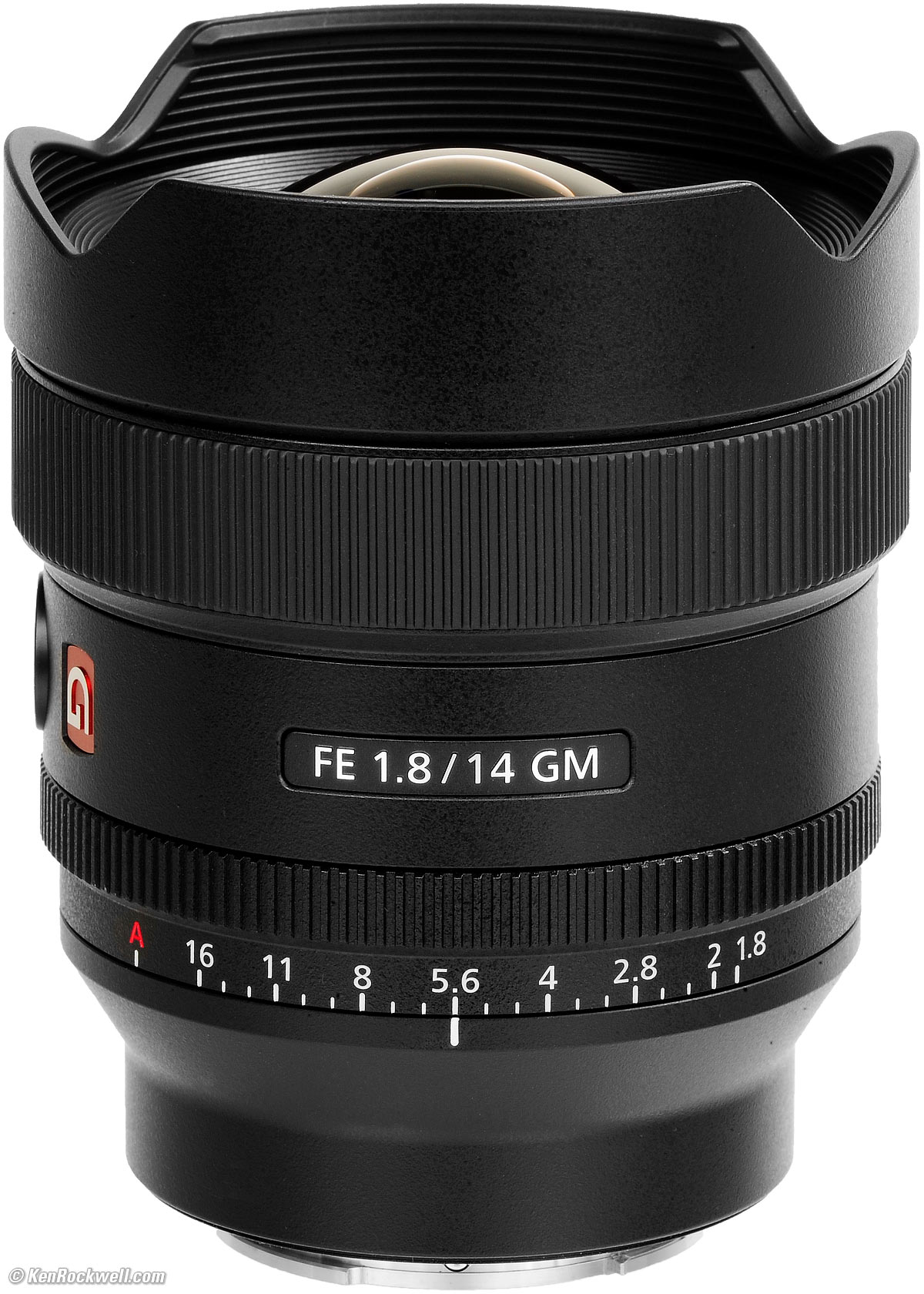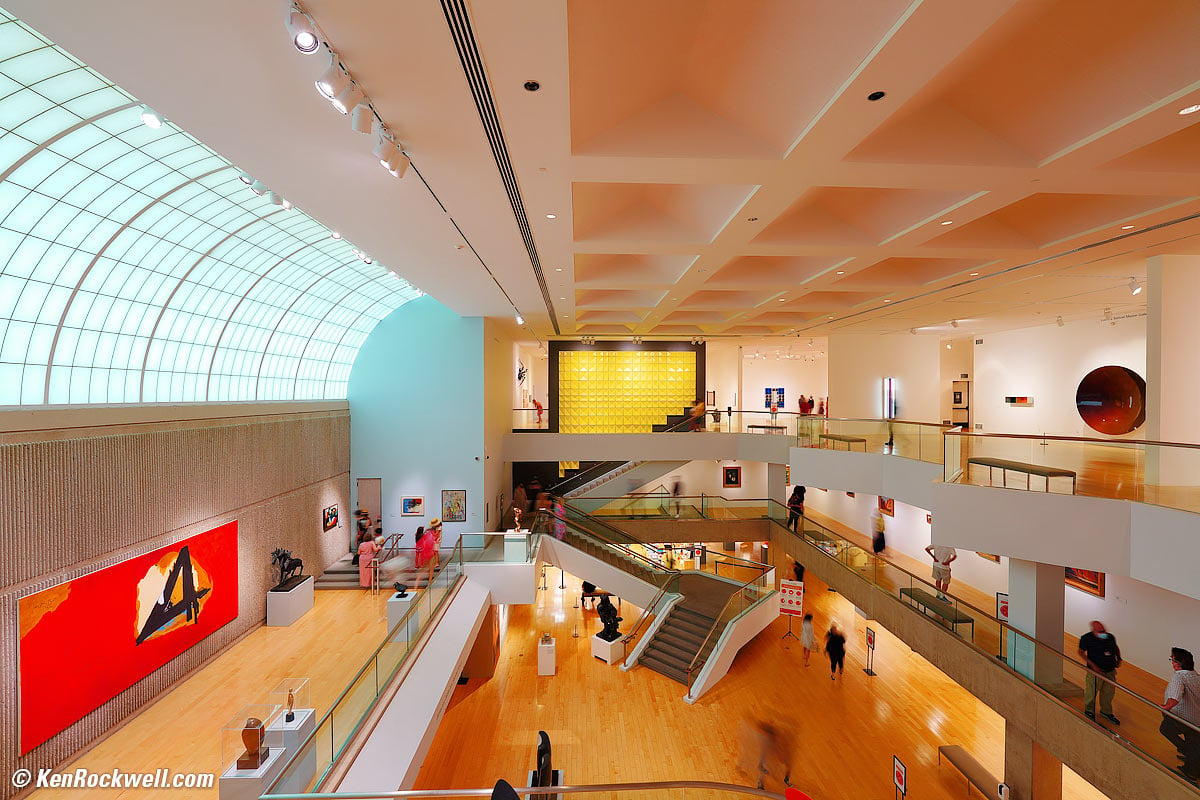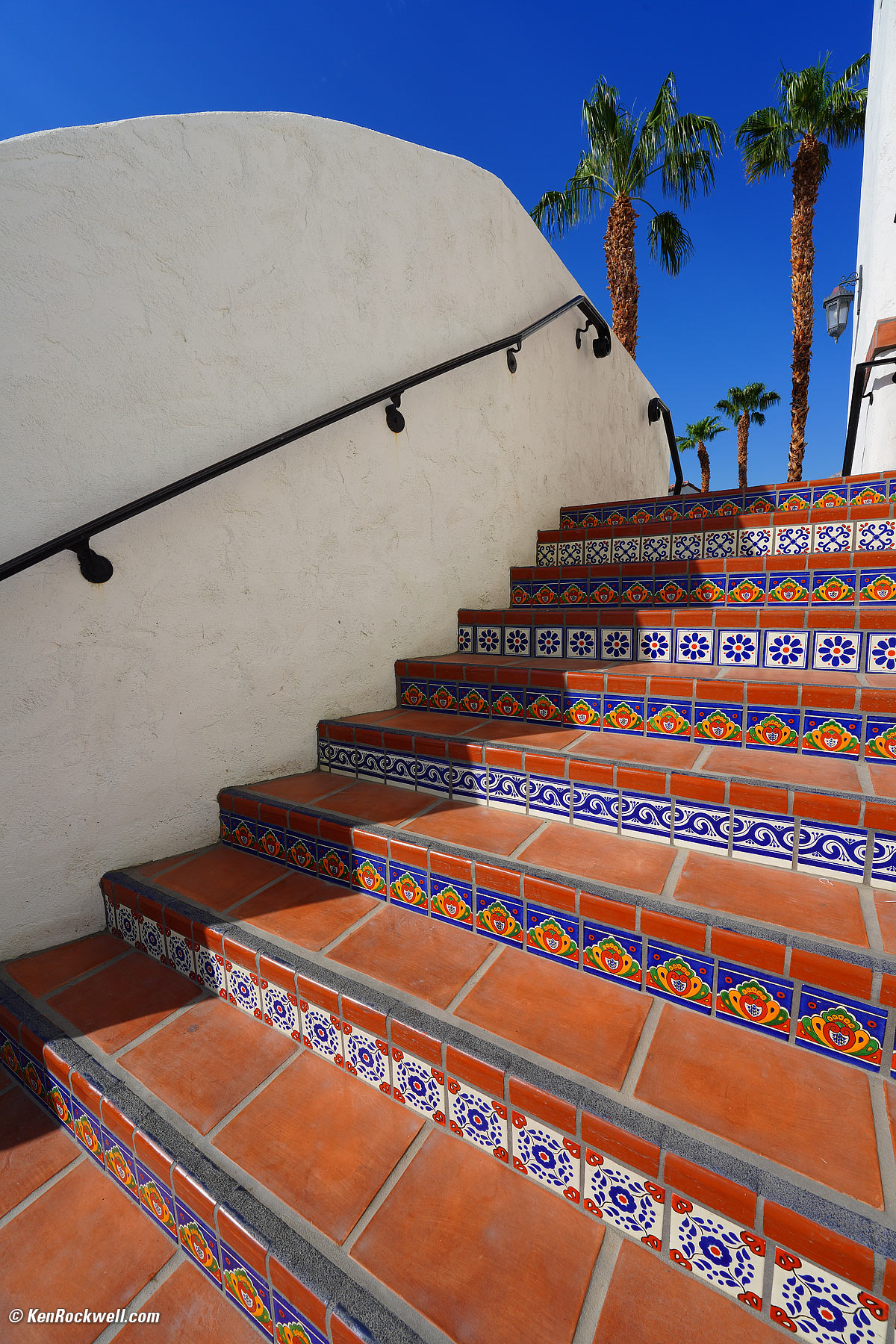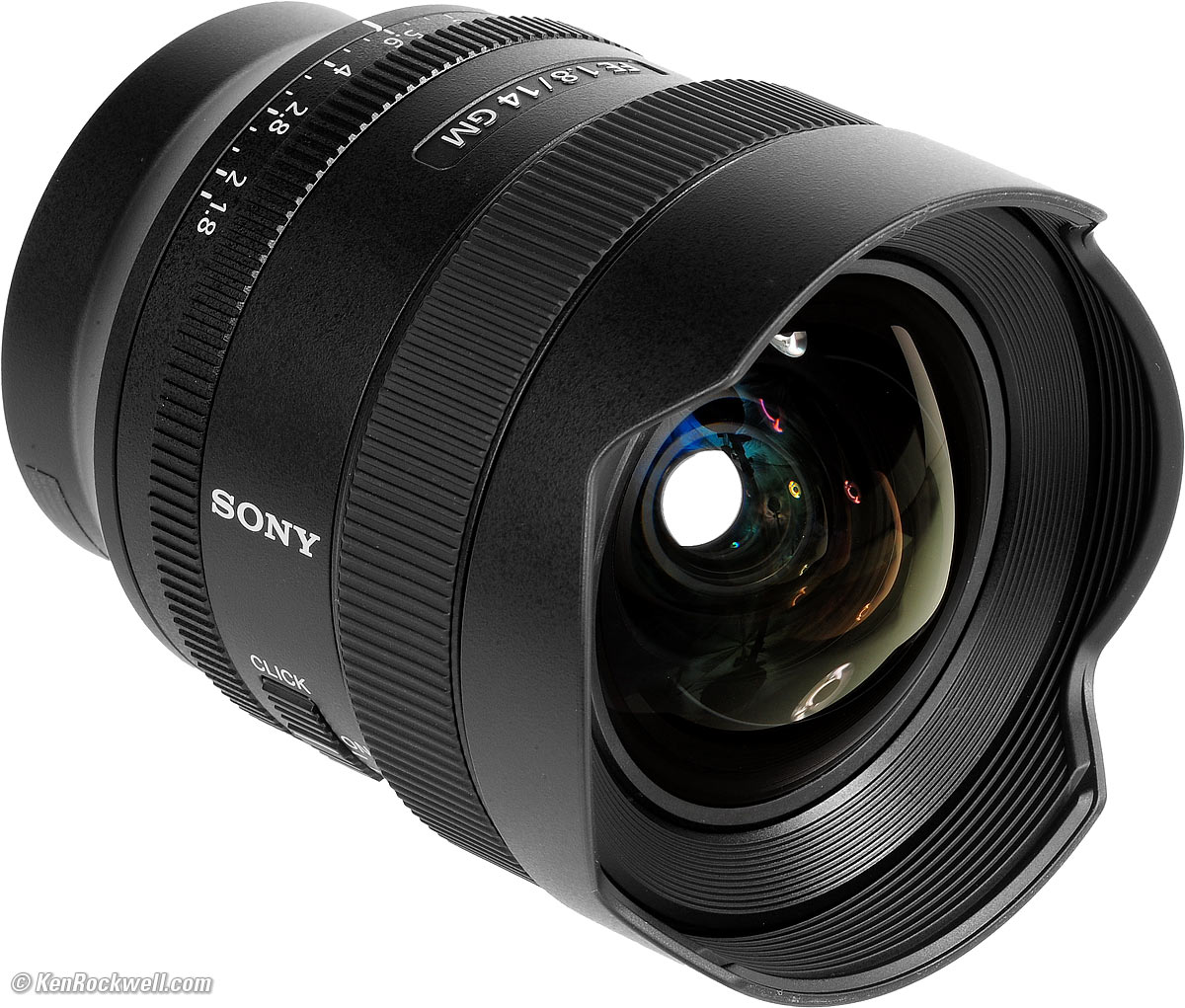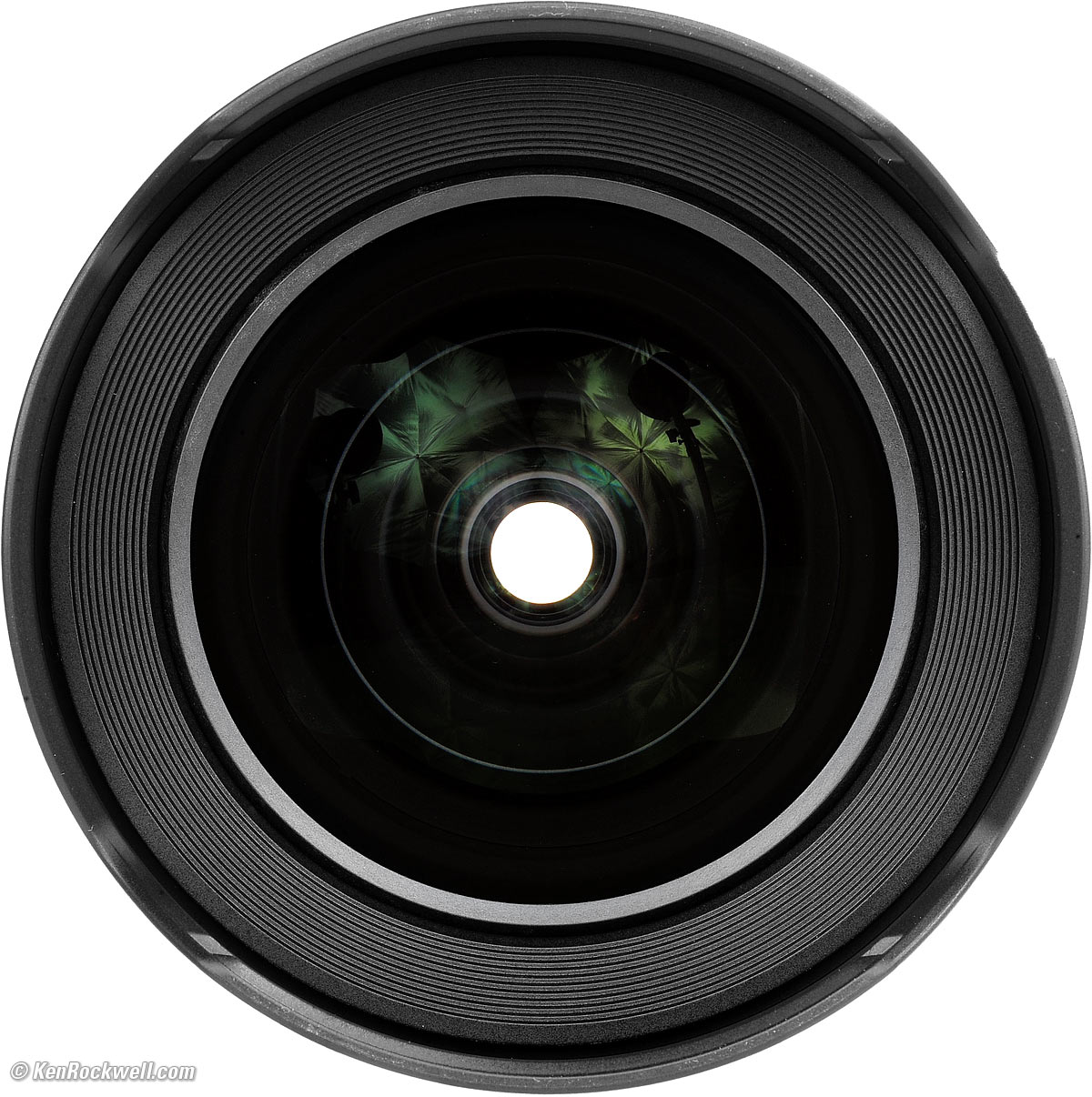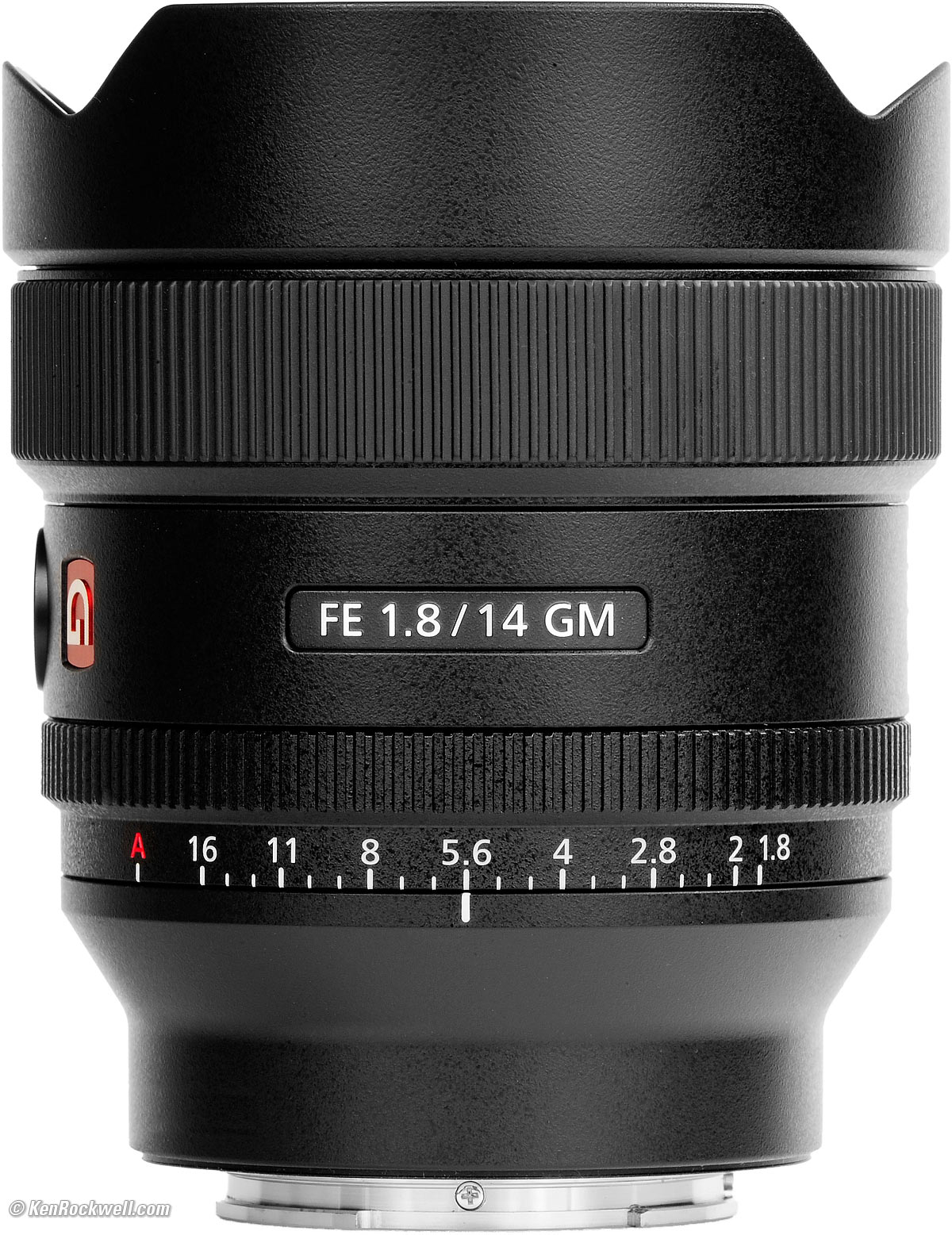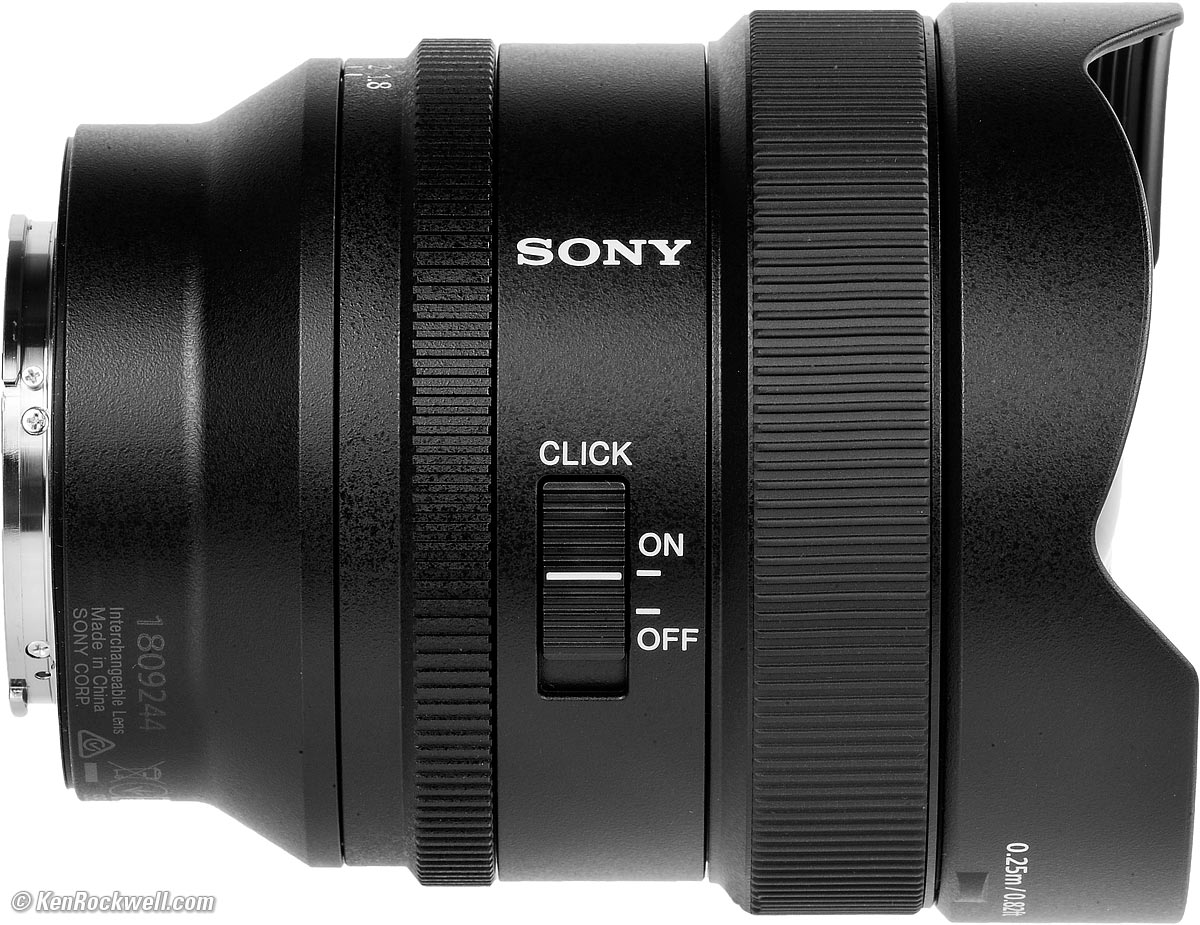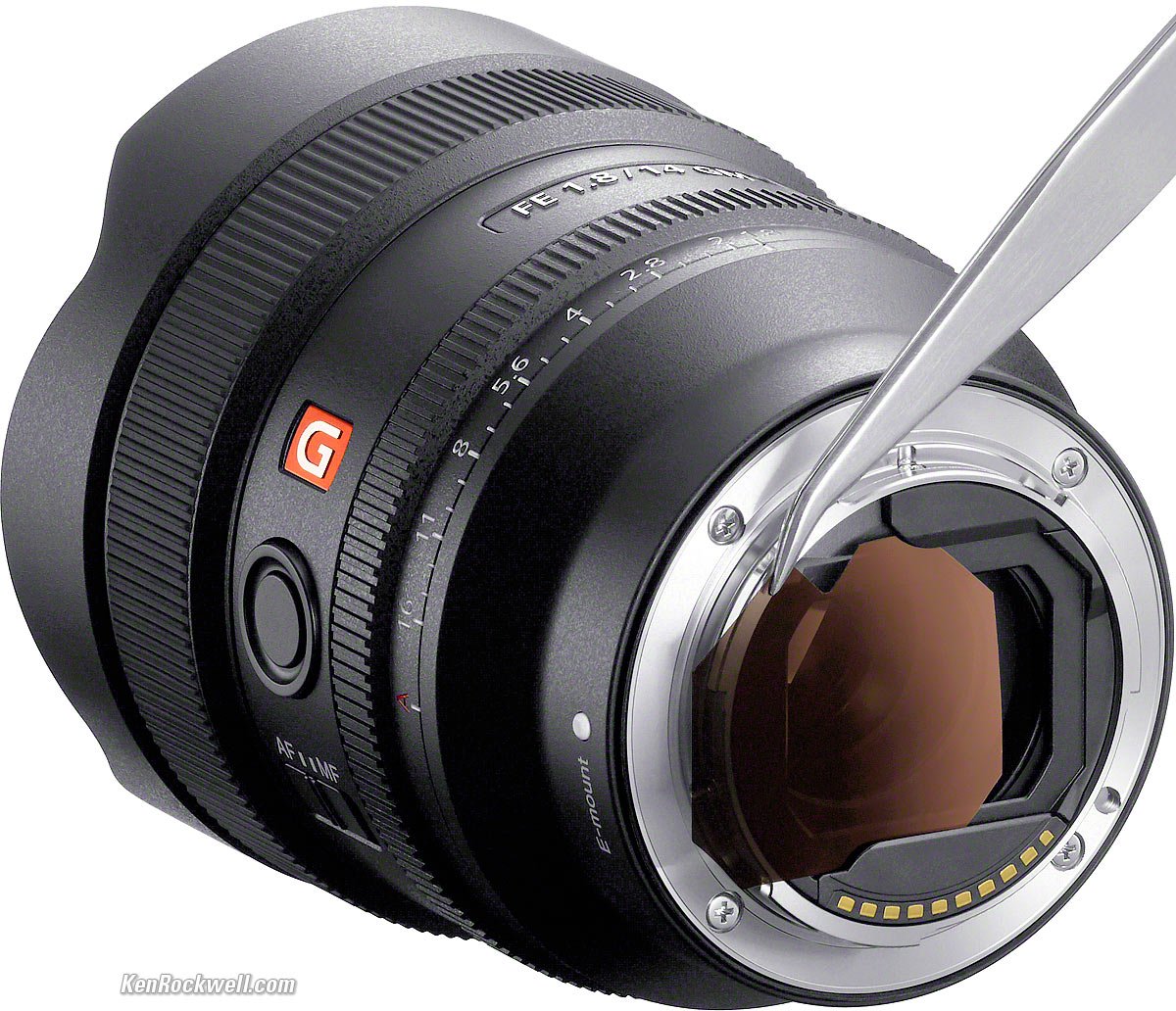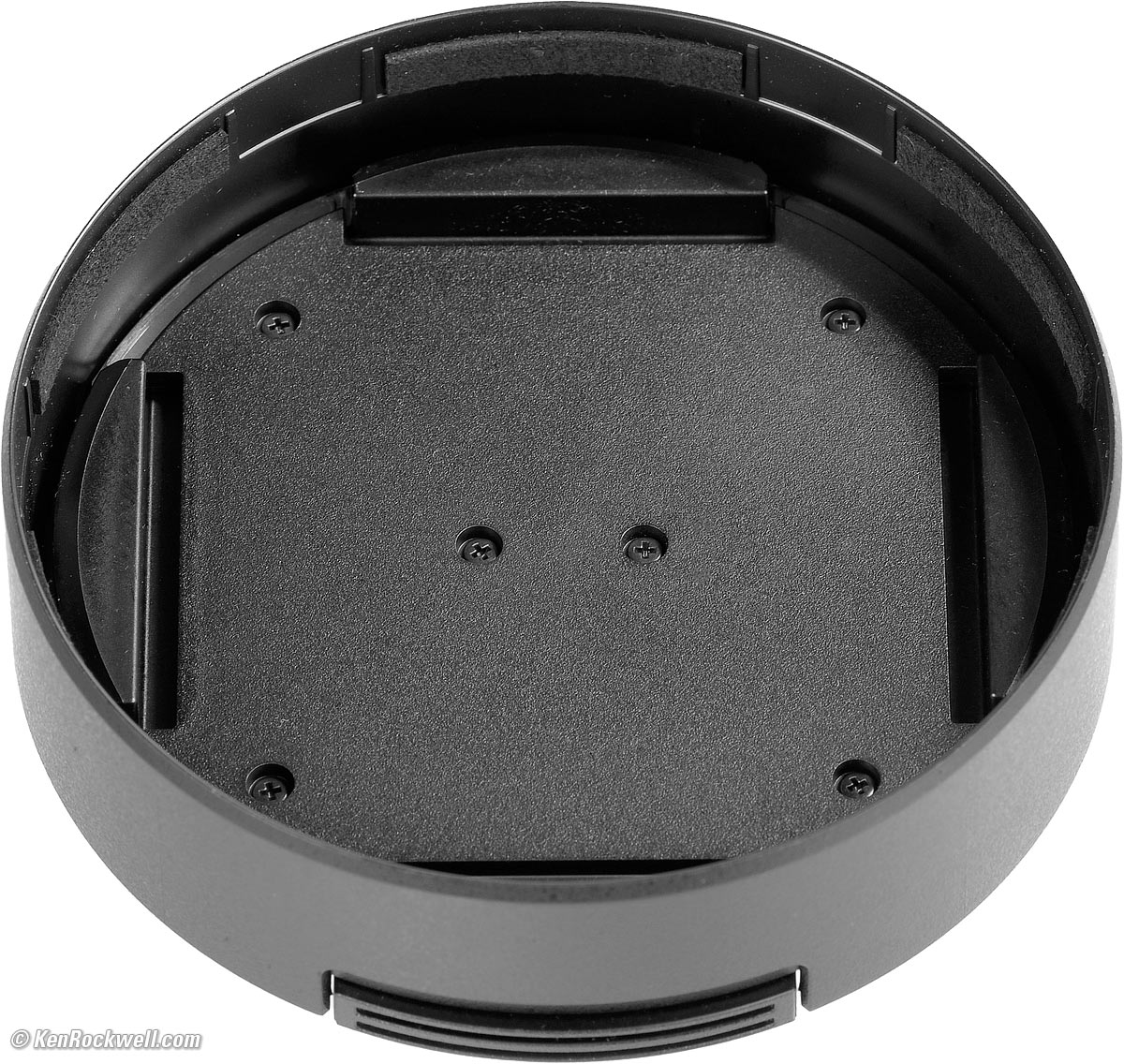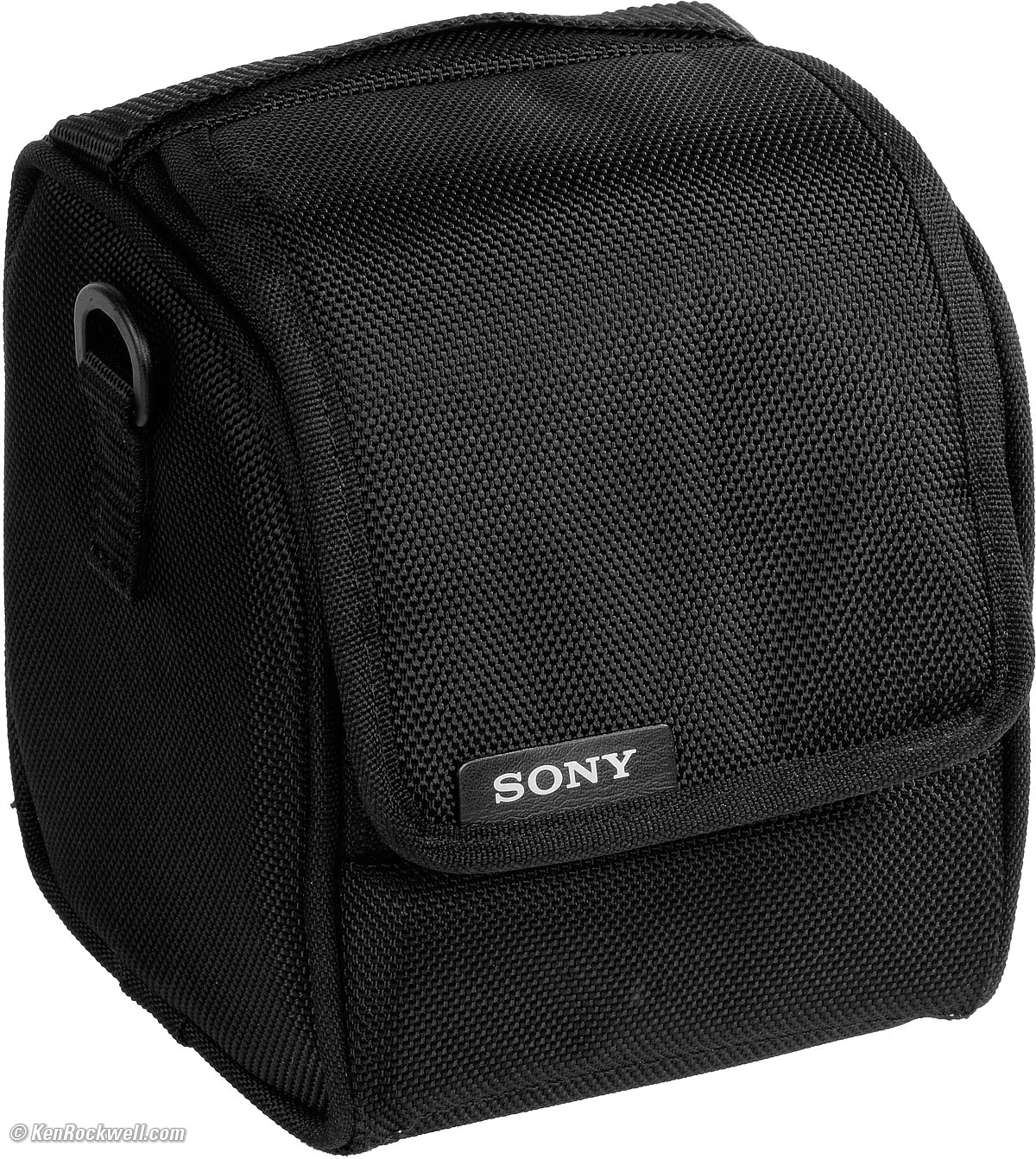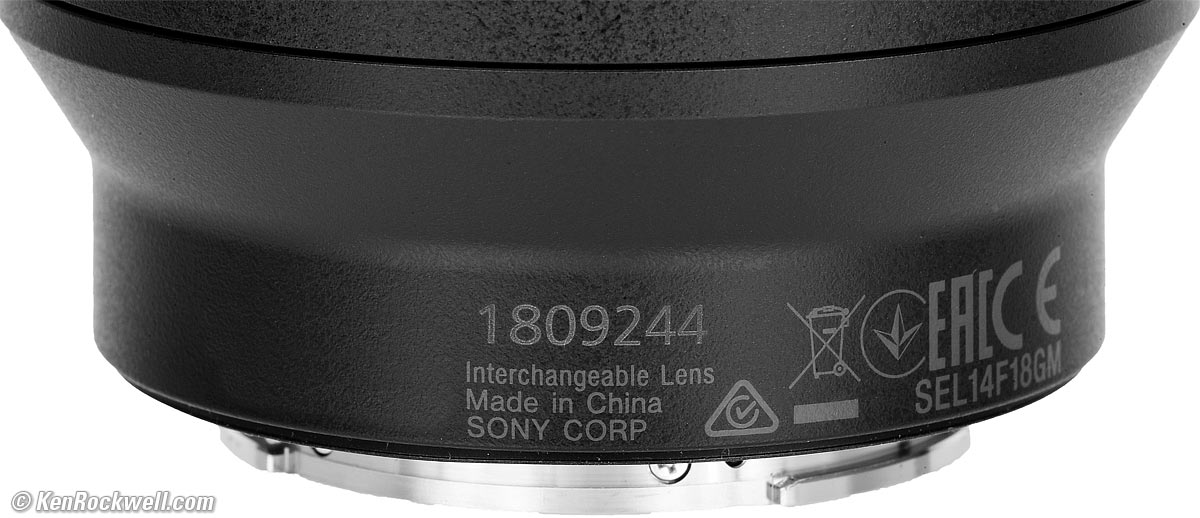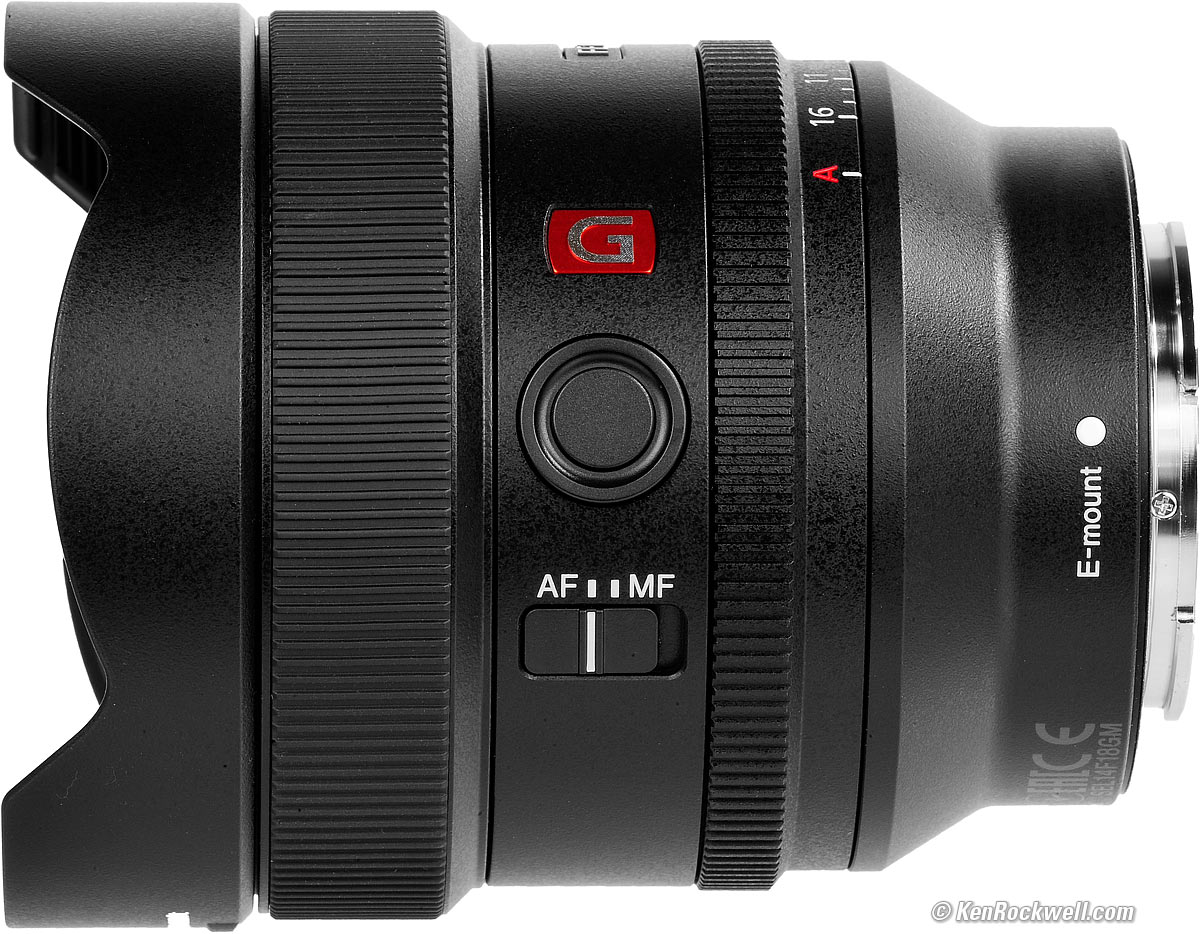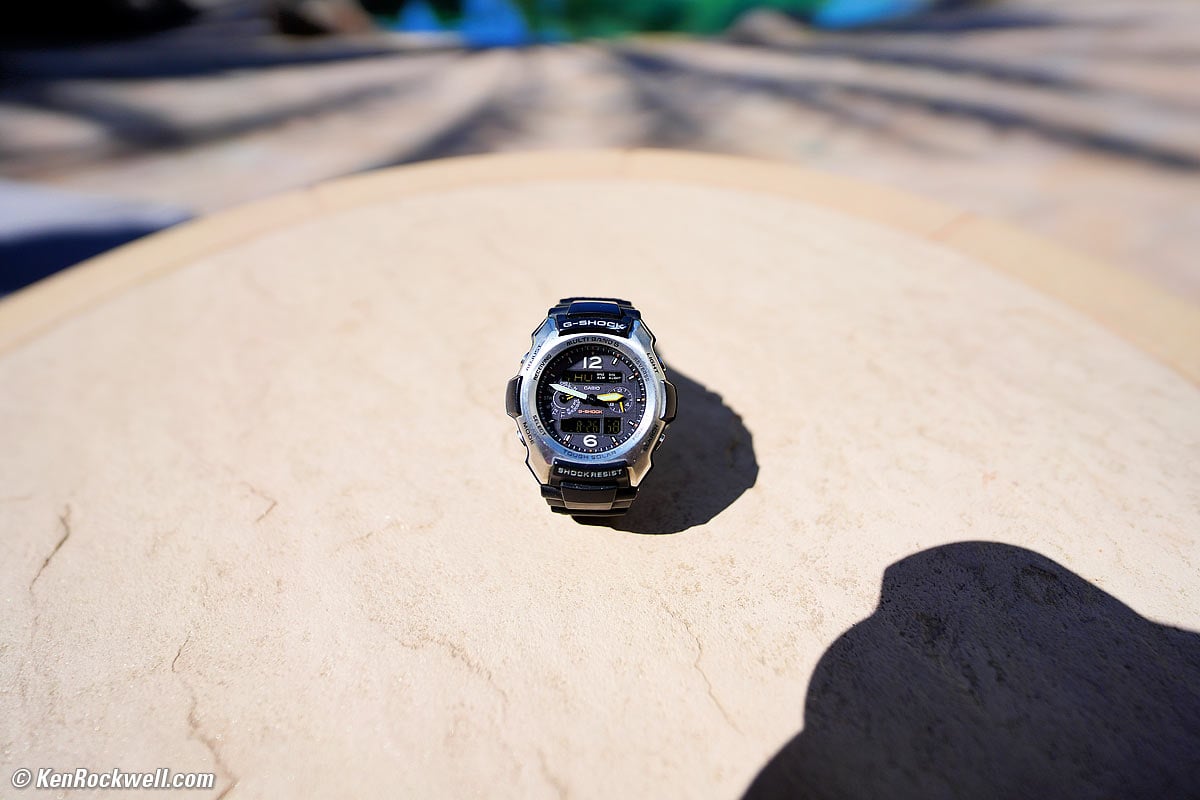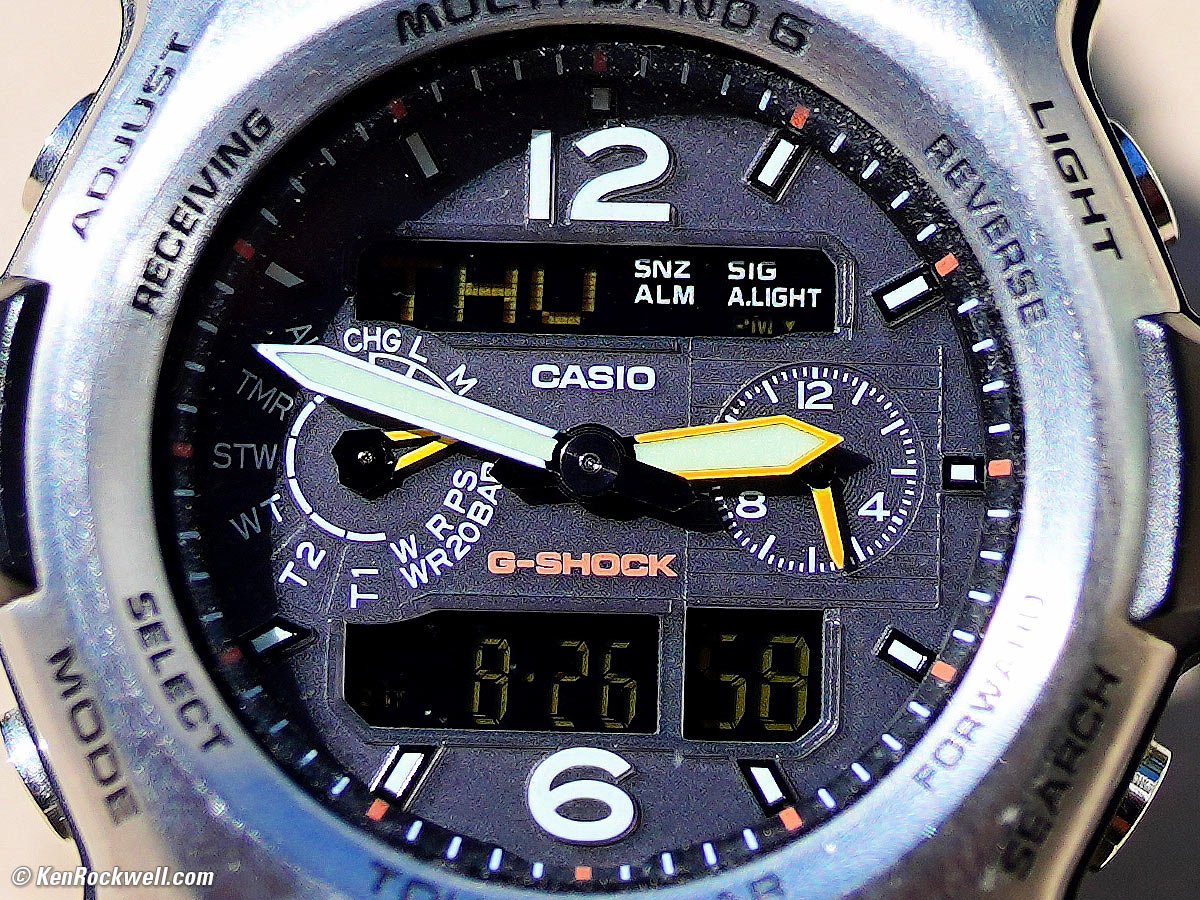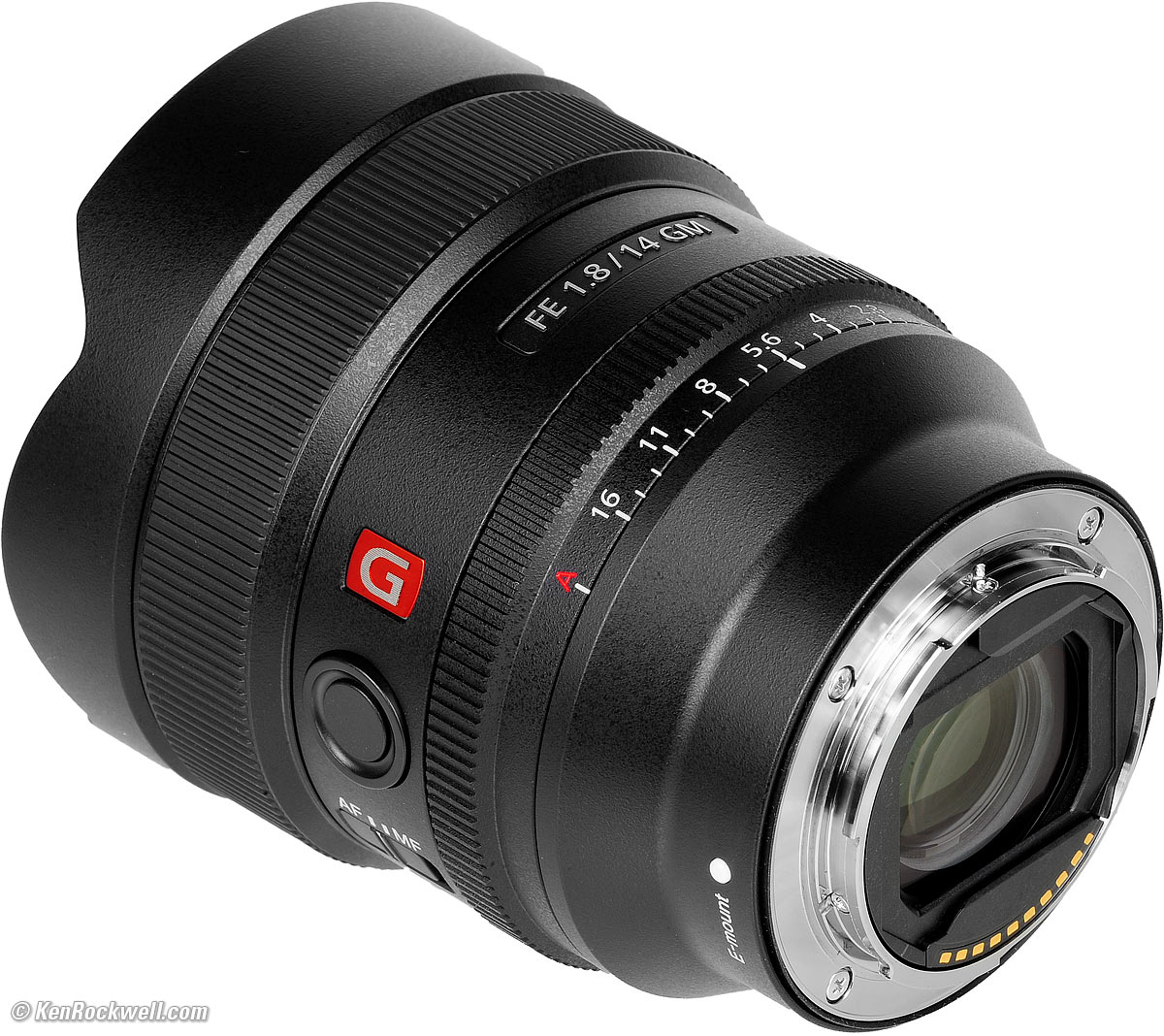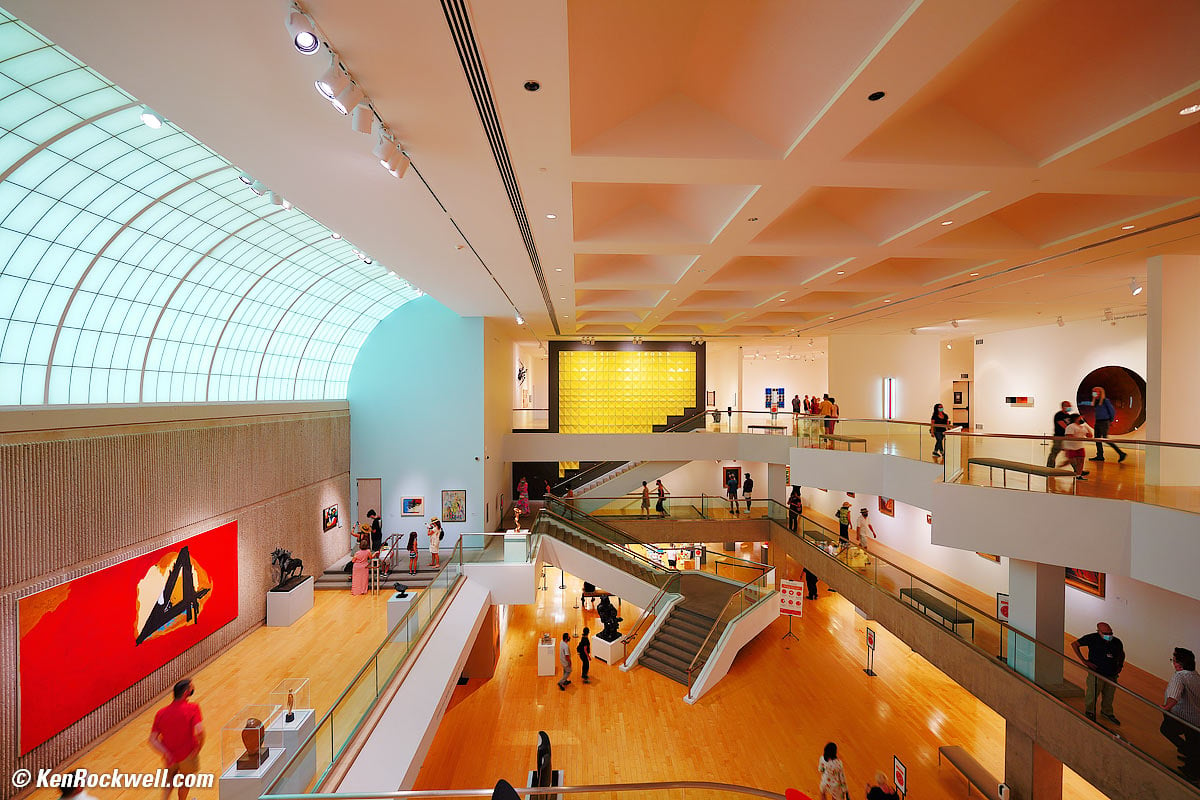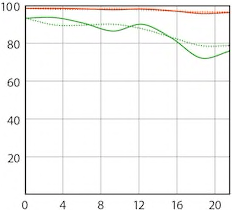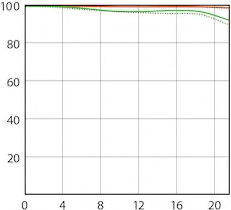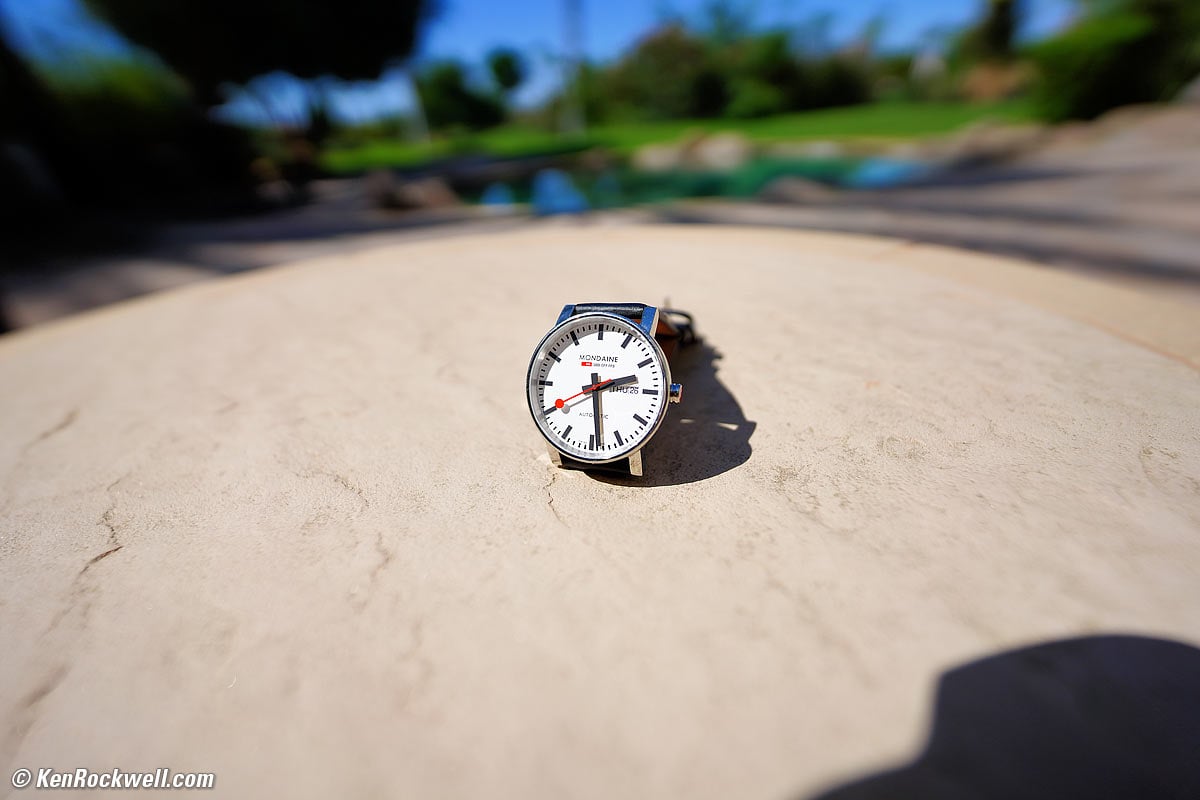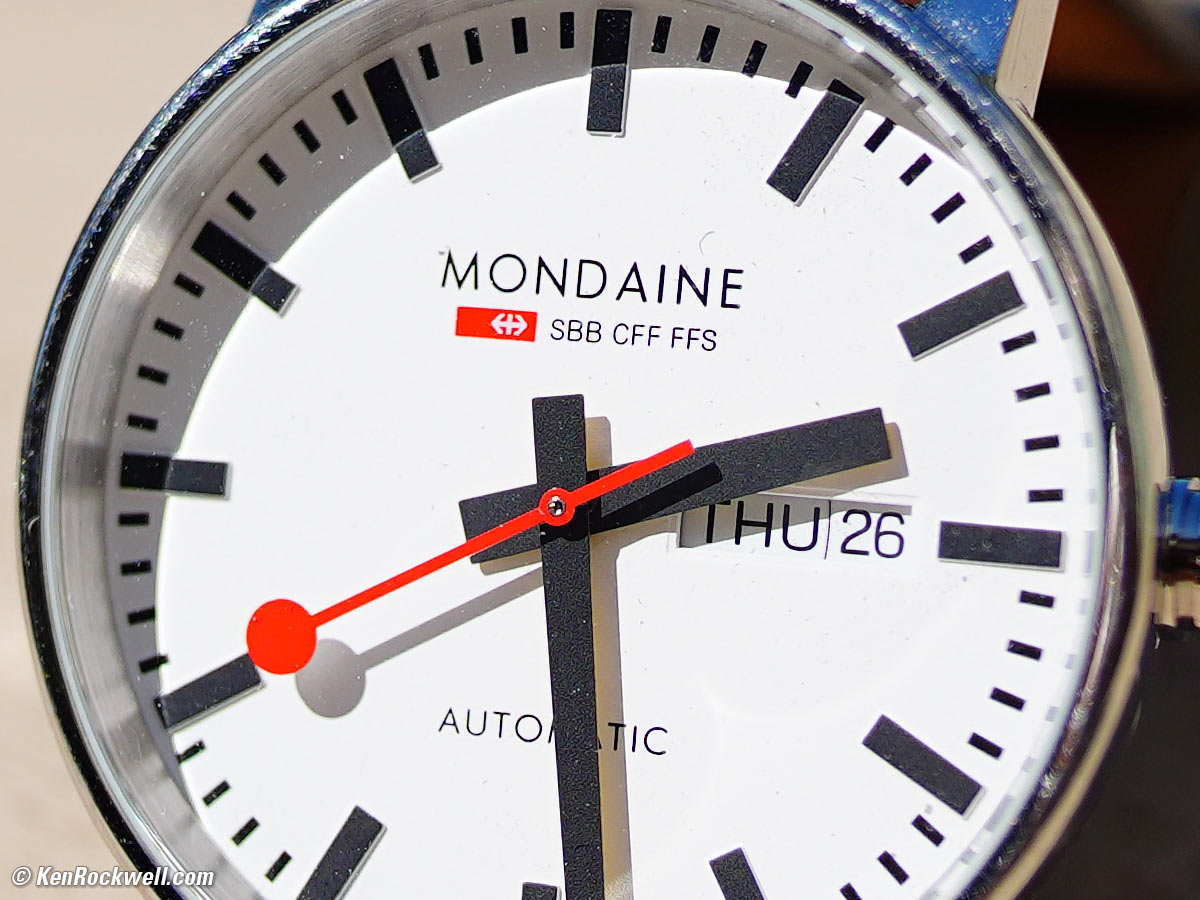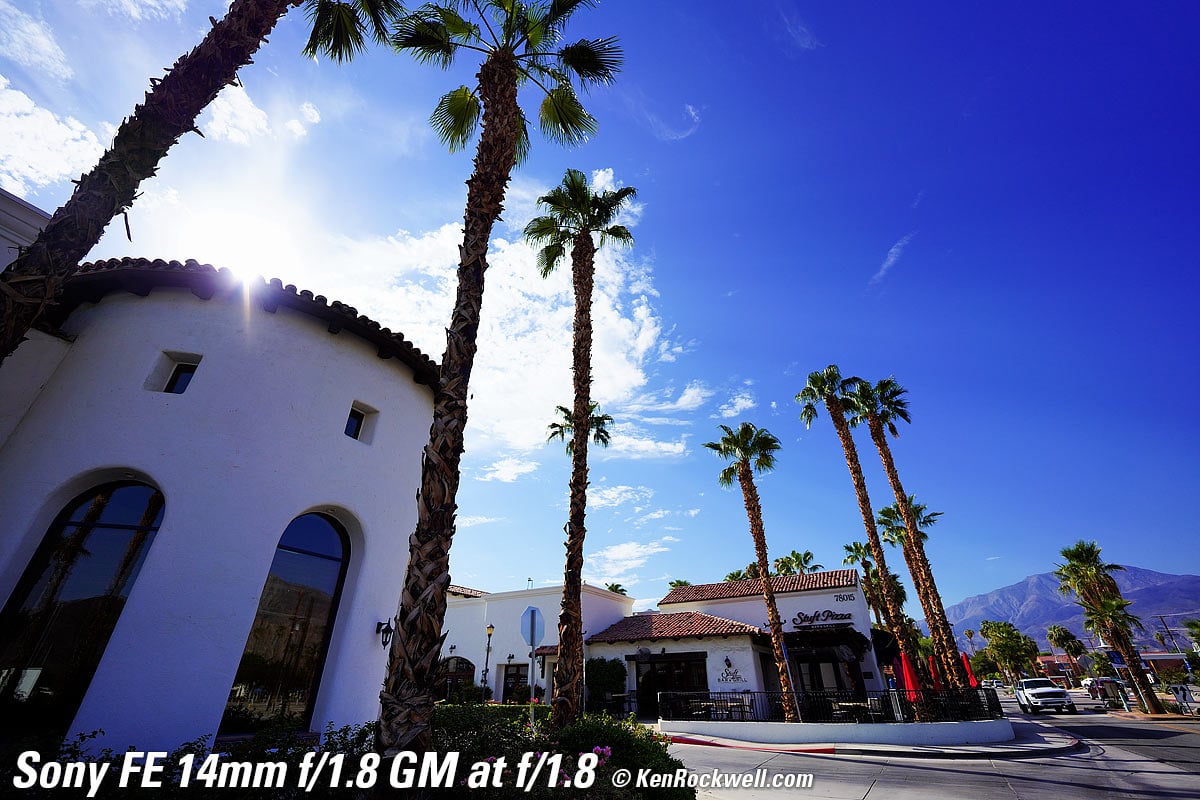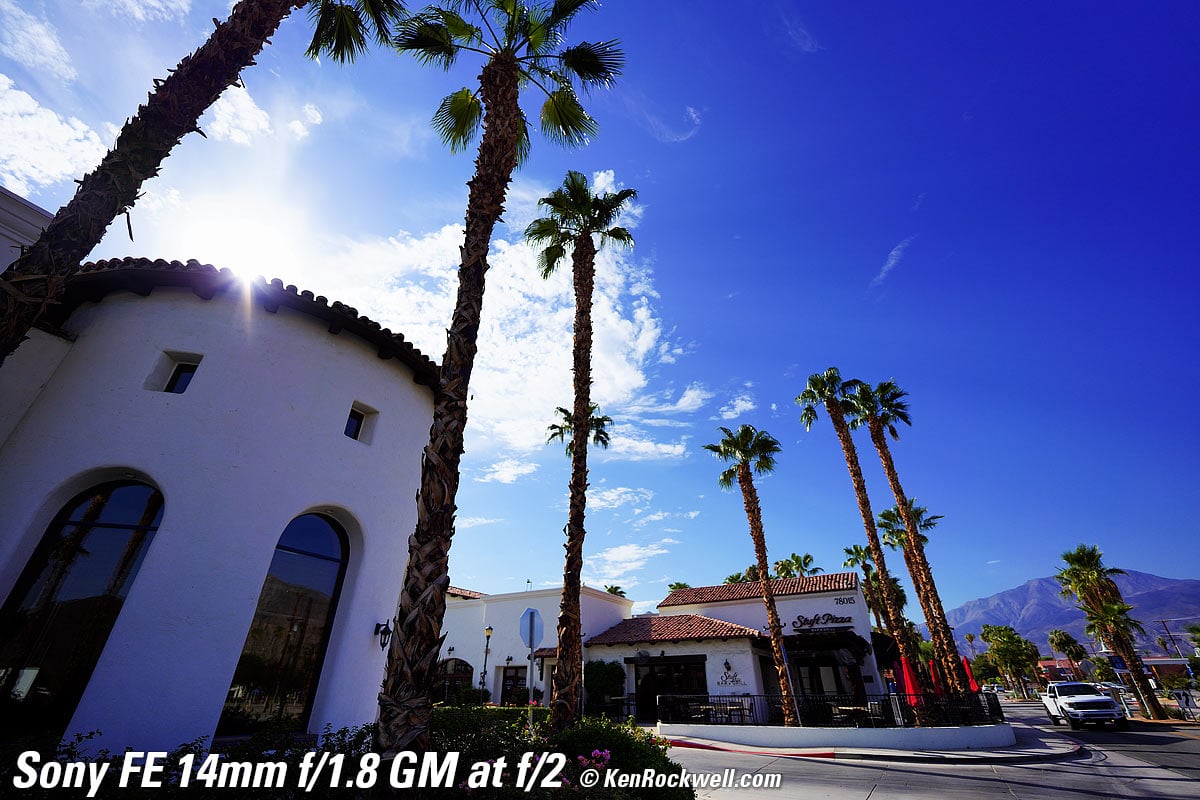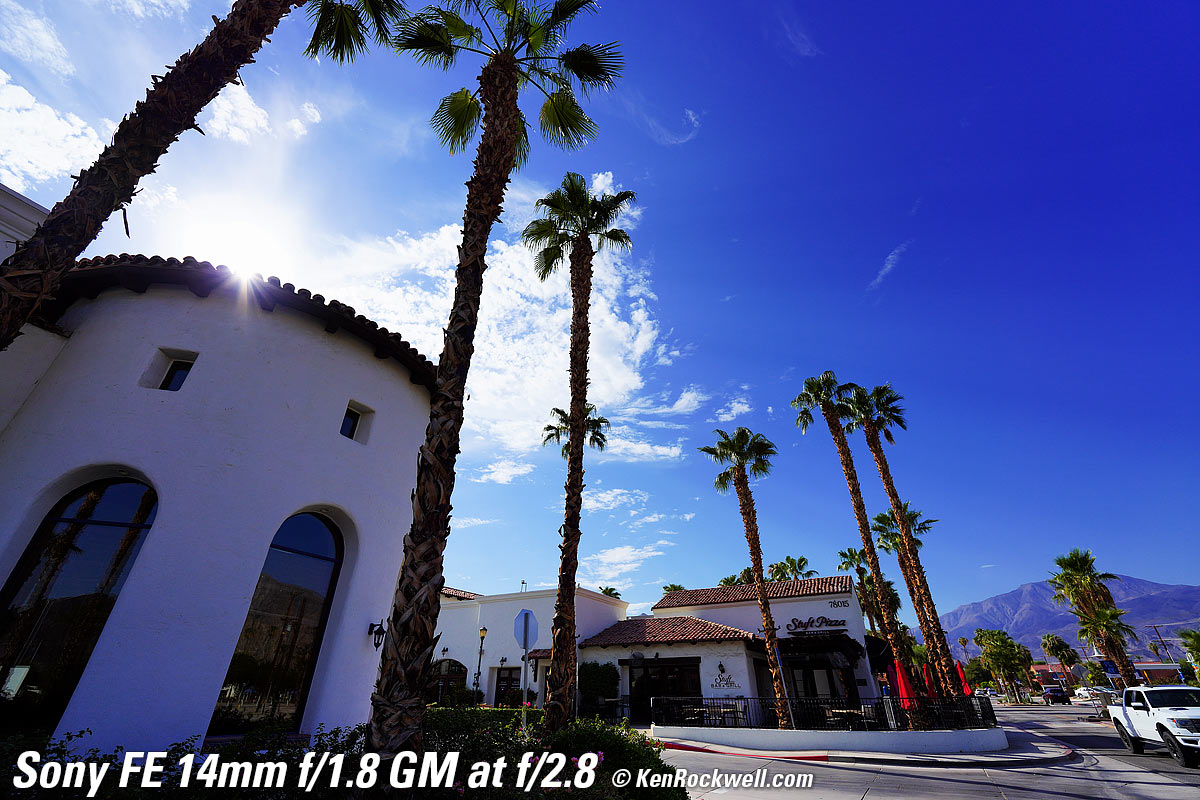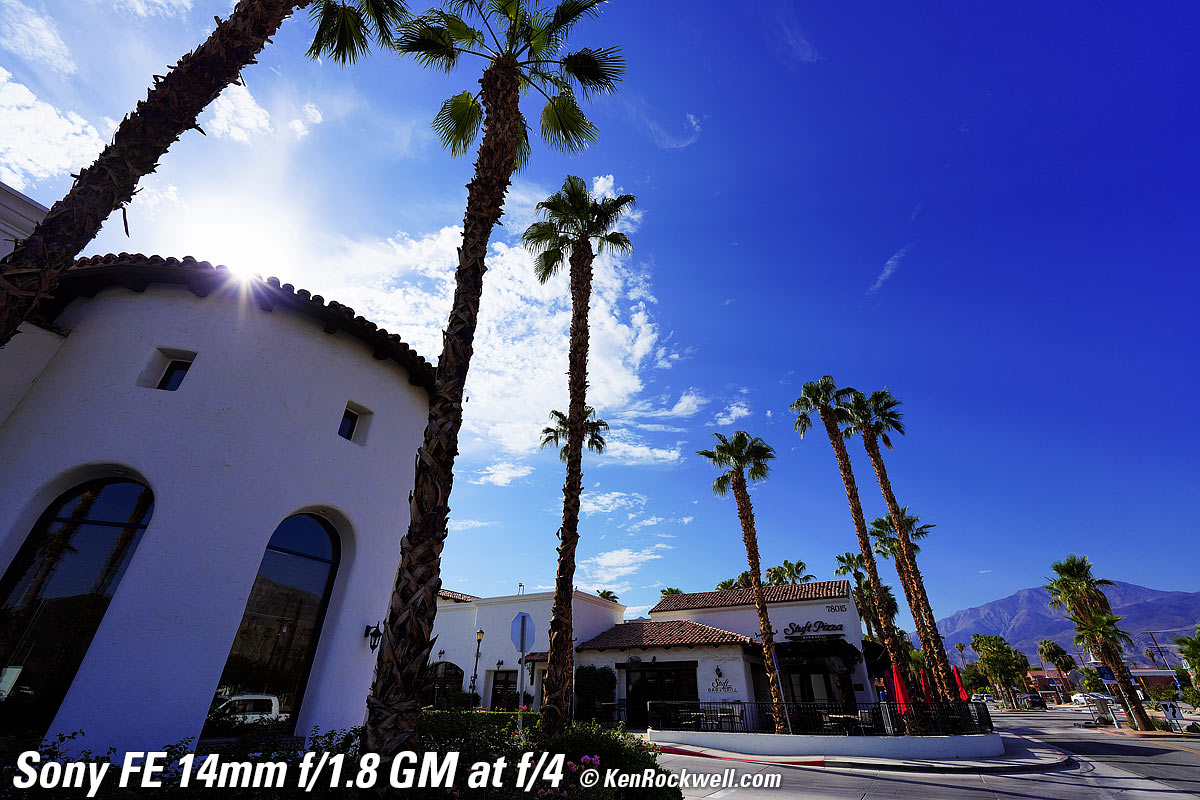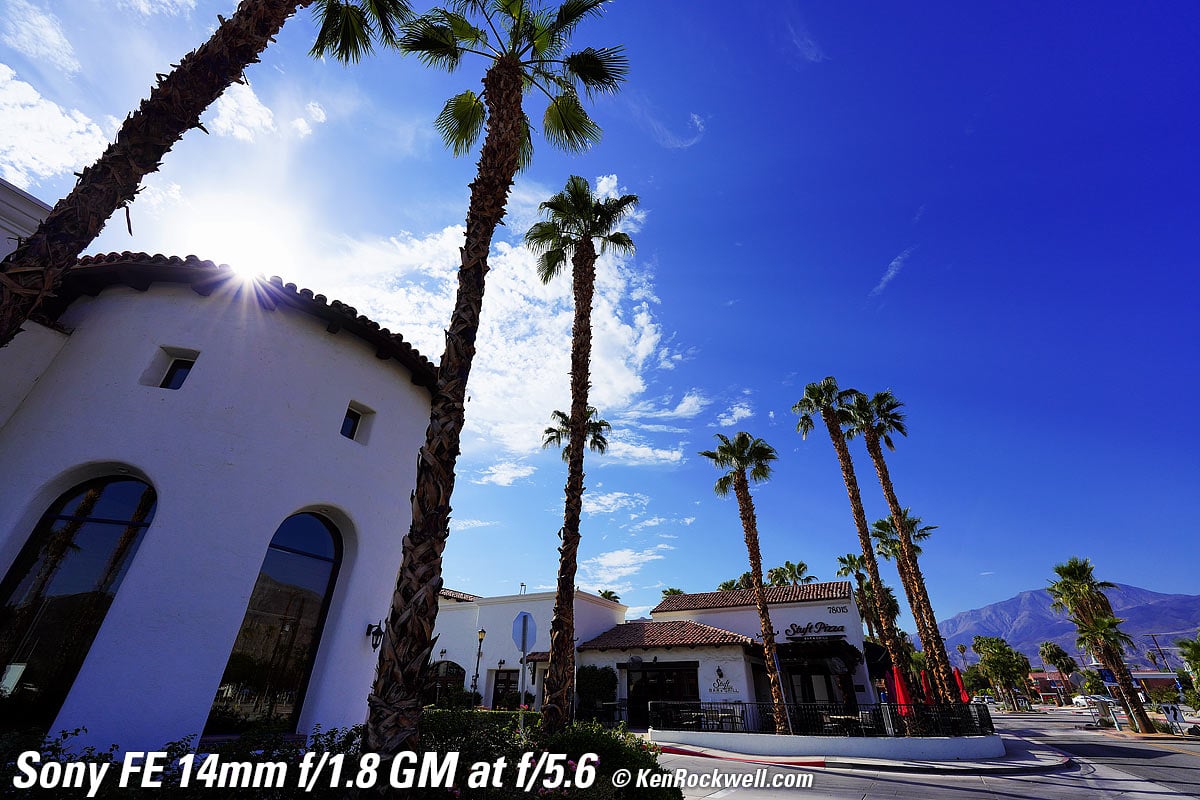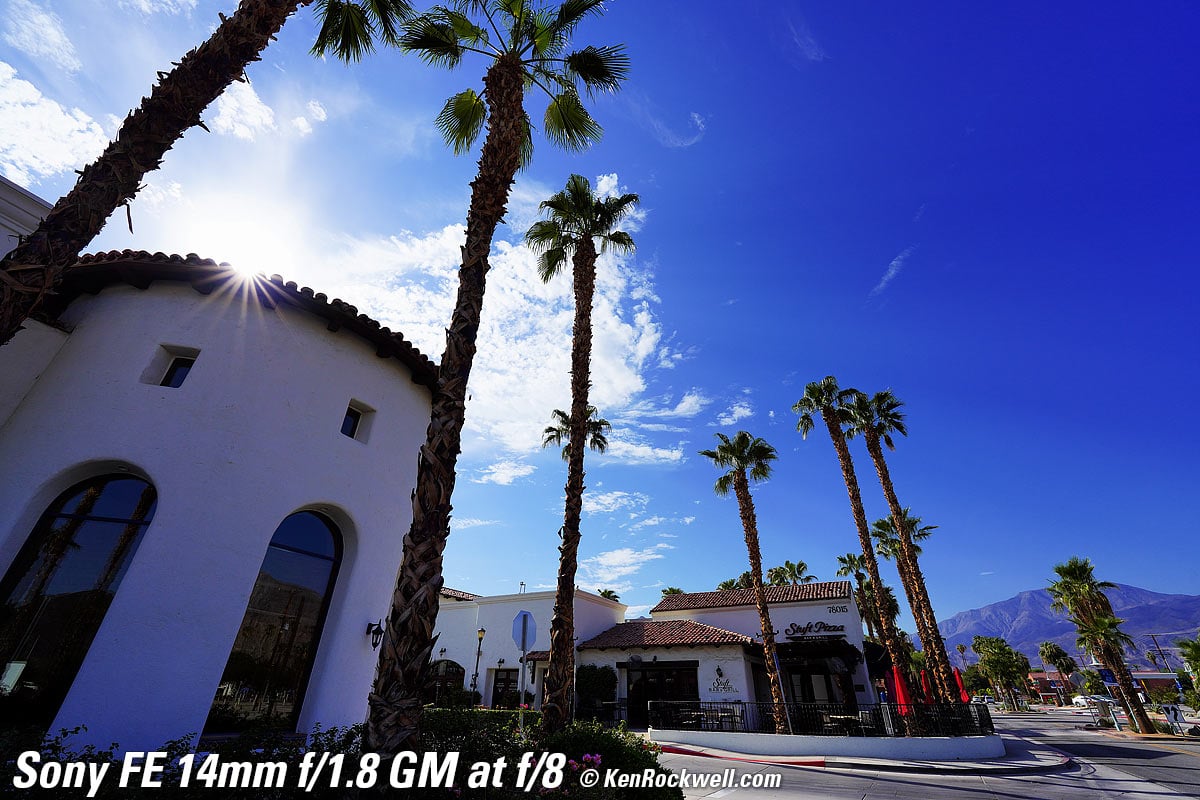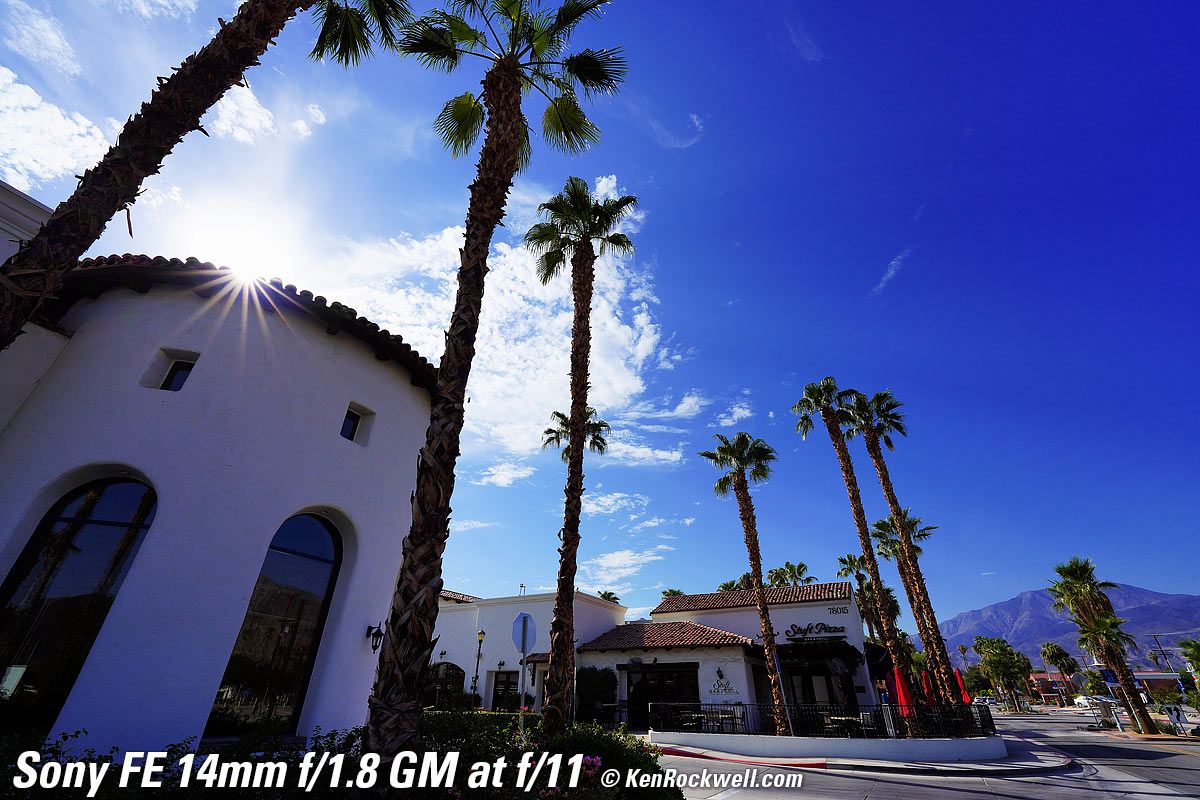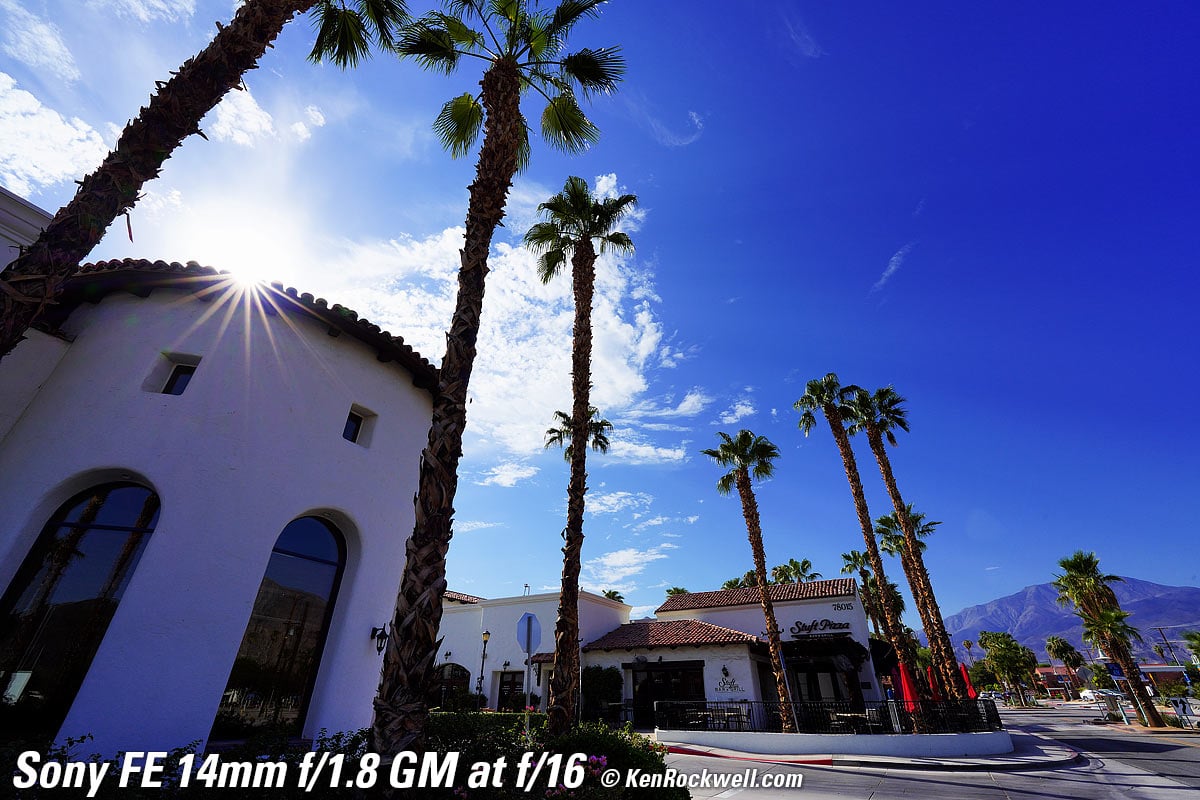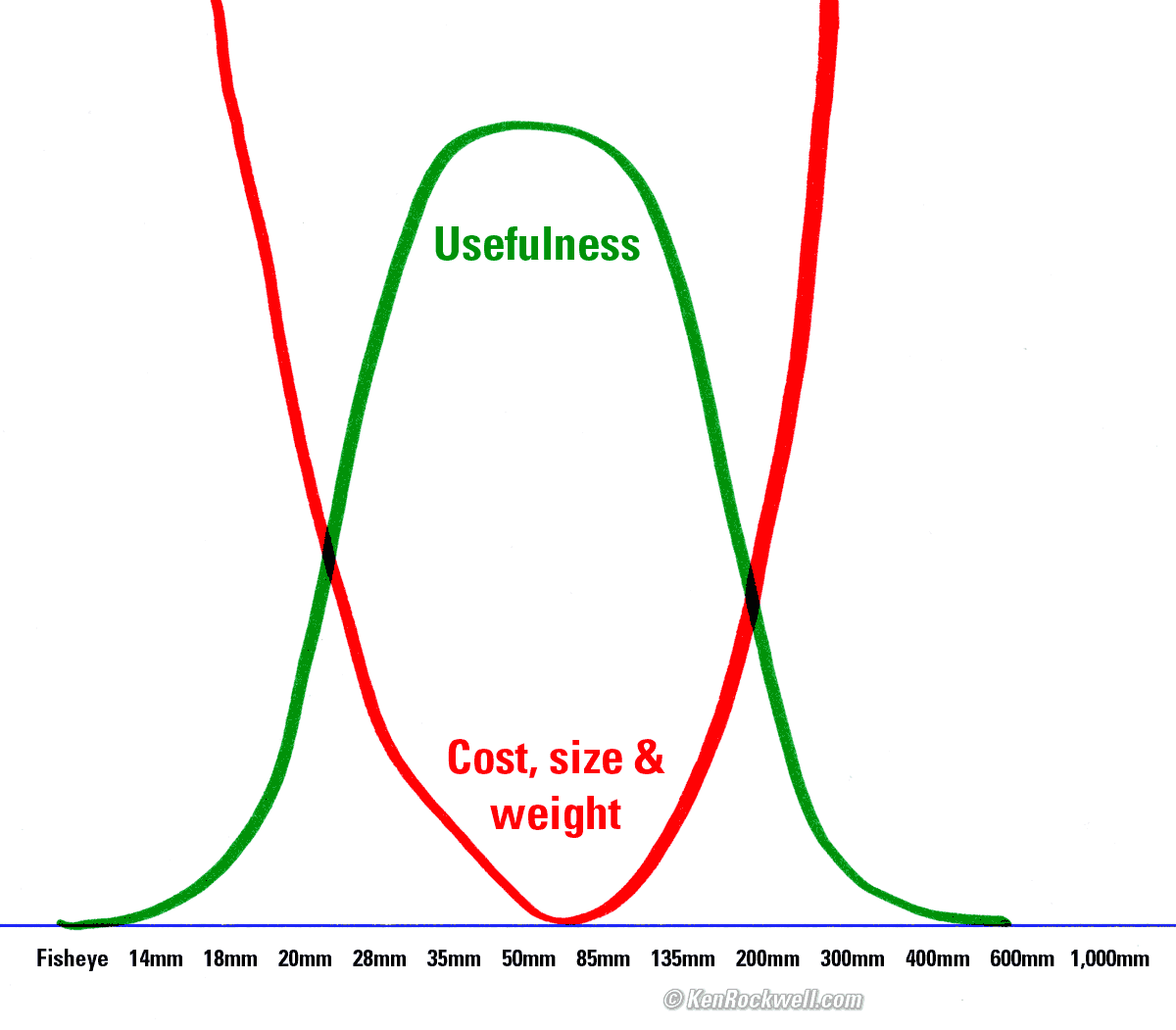Sony FE 14mm f/1.8 GM
Full-Frame, Ultra-Speed, Ultra Compact 114º Ultra-Ultra Wide
World's Best Fixed 14mm Lens
New Good Bad Missing Format Compatibility
Specifications Performance Compared
Sony FE 14mm f/1.8 GM (works with rear gel filters only, 16.3 oz./460 g, 0.8'/0.25m close focus, $1,598). bigger. I'd get mine at B&H, at Adorama, at Amazon or at Crutchfield, or eventually used at eBay if you know How to Win at eBay.
This 100% all-content, junk-free website's biggest source of support is when you use those or any of these links to my personally approved sources I've used myself for way over 100 combined years when you get anything, regardless of the country in which you live. Sony does not seal its boxes in any way, so never buy at retail or any other source not on my personally approved list since you'll have no way of knowing if you're missing accessories, getting a defective, damaged, returned, non-USA, store demo or used lens — and all of my personally approved sources allow for 100% cash-back returns for at least 30 days if you don't love your new lens. I've used many of these sources since the 1970s because I can try it in my own hands and return it if I don't love it, and because they ship from secure remote warehouses where no one gets to touch your new lens before you do. Buy only from the approved sources I've used myself for decades for the best prices, service, return policies and selection.
September 2021 Better Pictures Sony Sony Lenses Canon Nikon Fuji LEICA Zeiss All Reviews
Why Fixed Lenses Take Better Pictures
Nikon 14mm f/2.8 AF-D (1999 ~ today, 667 g).
Canon EF 14mm f/2.8L II (2007 ~ today, 643 g).
Canon EF 14mm f/2.8L (1991 ~ 2007, 538 g).
Canon New FD 14mm f/2.8L (1982 ~ 1987, 490 g).
Sample Images top
New Good Bad Missing Format Compatibility
Specifications Performance Compared
More samples throughout this review at Bokeh, Macro, Sharpness, Spherochromatism and Sunstars.
These are just snapshots; my real work is in my Gallery.
These are all shot hand-held as STANDARD JPGs; no tripods, no Fine or Extra Fine JPGs or RAW files were used or needed.
Art Museum, 6:05 PM, 26 August 2021. A7R IV, Sony FE 14mm f/1.8 GM at f/5.6 hand-held at 1/1.2 of a second (braced on ledge), stabilization OFF, ISO 50 (LV 6.3), Perfectly Clear. bigger or camera-original © JPG file (60 MP, 11 MB).
Shopping Palms, 8:03 PM, Thursday, 26 August 2021. A7R IV, Sony FE 14mm f/1.8 GM wide-open at f/1.8 hand-held at 1/15 of a second, stabilization OFF because I forgot to turn it on in deep in a menu, Auto ISO 1,000 (LV 2.3), Perfectly Clear. bigger or camera-original © JPG file (60 MP, 20 MB).
Remember that the depth of field at f/1.8 is quite limited; much of this image isn't in focus even though the lens is super sharp.
Seven Palms Oasis, 6:34 PM, Sunday, 29 August 2021. A7R IV, Sony FE 14mm f/1.8 GM wide-open at f/1.8 at 1/1,000, Auto ISO 100 (LV 11⅔), Perfectly Clear. bigger or camera-original © JPG file (60 MP, 19 MB).
This is ultra-sharp, shot wide-open at f/1.8! 14mm lenses never, every used to be this spectacularly sharp, especially wide-open and especially out in the corners.
Remember that the depth of field at f/1.8 here is quite limited; much of this image, especially the foreground, isn't in focus even though the lens itself is super sharp where it is in focus.
One West Bank with Old Moon in Sky, 9:12 AM, Monday, 30 August 2021. A7R IV, Sony FE 14mm f/1.8 GM at f/8 at 1/320 at Auto ISO 100 (LV 14.3), as shot. bigger or camera-original © JPG file (60 MP, 14 MB).
Even illumination and no visible peripheral color shift, both banes of previous 14mm lenses.
Spanish Tile Staircase, 9:12 AM, Monday, 30 August 2021. A7R IV, Sony FE 14mm f/1.8 GM at f/11 at 1/200 at Auto ISO 100 (LV 14.6), exactly as shot. bigger or camera-original © JPG file (60 MP, 17 MB).
Sevilla, Spain, 9:28 AM, Monday, 30 August 2021. Cropped from A7R IV, Sony FE 14mm f/1.8 GM at f/8 at 1/640 at Auto ISO 100 (LV 15.3), Perfectly Clear. bigger, full resolution (60 MP, 13 MB) or camera-original © JPG file (60 MP, 11 MB).
Introduction top
New Good Bad Missing Format Compatibility
Specifications Performance Compared
|
I buy only from these approved sources. I can't vouch for ads below. |
This Sony FE 14mm f/1.8 GM is a ground-breaking ultra-ultrawide lens because it's 1⅓ stops faster than any other professional 14mm lens, it's optically nearly flawless and it's also the smallest and lightest 14mm ever made! Bravo, Sony!!!
Sony's been playing catch-up for years. Even today Sony's "new" FE 35/1.4 GM isn't; LEICA had their first much smaller 35/1.4 for mirrorless in 1960 and Nikon had their first in 1969, and Sony's "new" FE 50mm f/1.2 GM isn't new either by a longshot as Nikon had a 50mm f/1.1 in 1956, LEICA had a 50mm f/1.2 ASPH in 1966 and Canon had a 50mm f/0.95 in 1961 — all three for mirrorless! Hallelujah; this 14mm is something genuinely new and useful.
For general use I prefer the more flexible (but still somewhat heavier) FE 12-24mm f/4 G and others might prefer the huge FE 12-24mm f/2.8 GM, this new 14mm f/1.8 is smaller than any of these, and much faster. Speed is important for astronomical use; ultrawides are awful lenses to use for portraits and even if you do there is almost never anything that far out of focus.
This new lens it the best lens you can get anywhere for milky-way and astrophotography because f/1.8 means you can shoot at a much lower ISO or spend less than half as much time waiting around out in the cold to get the same images as an f/2.8 lens, and its ultra-ultrawide angle also means you can expose for longer without worrying about stars blurring or needing a clock drive to counteract the rotation of the earth.
Its light weight also makes it much more compatible with gimbals, UAVs and drones, with which the extra weight of the older ultrawides made it much more difficult and expensive.
Unlike most yawner "news" recently this really is new and expands the envelope of conditions over which I can bring back better images. The speed is critical for astronomical use because it saves me exposure time. High ISOs are for the weak; I prefer to shoot all my night work at ISO 100 for the very cleanest results, which results in a lot of time spent out in the cold.
Be careful; few people know How to Use Ultrawide Lenses. 14mm lenses require great skill for impressive results for anything other than interior architectural shots. Beyond architectural and astrophotography 14mm lenses are much less useful than a 16-35mm or even a 24-240mm; 14mm is so ridiculously wide that it's used for occasional effect like hot sauce; even nuts like me who own many 14mm lenses rarely use them.
I'd get my 14mm f/1.8 at B&H, at Adorama, at Amazon or at Crutchfield, or eventually used at eBay if you know How to Win at eBay.
New Introduction top
 World's first major camera brand 14mm f/1.8.
World's first major camera brand 14mm f/1.8.
 World's smallest and lightest 14mm.
World's smallest and lightest 14mm.
Good Introduction top
 Near optical perfection:
Near optical perfection:
 Ultrasharp, even wide-open in the corners. This lens is worlds sharper out there than Nikon's 14mm f/2.8 AF-D or Canon's EF 14mm f/2.8 L II.
Ultrasharp, even wide-open in the corners. This lens is worlds sharper out there than Nikon's 14mm f/2.8 AF-D or Canon's EF 14mm f/2.8 L II.
 Very little distortion, even uncorrected.
Very little distortion, even uncorrected.
 Great bokeh, not that you'll ever notice with a lens this wide.
Great bokeh, not that you'll ever notice with a lens this wide.
 Remarkably little falloff.
Remarkably little falloff.
 Remarkably few to no ghosts or flare.
Remarkably few to no ghosts or flare.
 Essentially no lateral color.
Essentially no lateral color.
 Essentially no spherochromatism.
Essentially no spherochromatism.
 Essentially no peripheral color shift.
Essentially no peripheral color shift.
 Excellent Sunstars.
Excellent Sunstars.
 Brilliantly simple and effective front cap system, which greatly improves the ergonomics and usability of this lens with a huge, bulbous front element that can't be protected with a filter.
Brilliantly simple and effective front cap system, which greatly improves the ergonomics and usability of this lens with a huge, bulbous front element that can't be protected with a filter.
 Dedicated aperture ring with defeatable clicks.
Dedicated aperture ring with defeatable clicks.
 Programmable function button, usually set to Focus Lock.
Programmable function button, usually set to Focus Lock.
 These optics could never have been done today for DSLR lenses. The fact that the back of the lens can get much closer to the image sensor because there's no reflex mirror in the way gives optical designers the freedom to make ultrawide lenses faster, sharper, wider and much smaller than possible with DSLR lenses like the Nikon AF-D 14mm f/2.8 and Canon EF 14mm f/2.8L II.
These optics could never have been done today for DSLR lenses. The fact that the back of the lens can get much closer to the image sensor because there's no reflex mirror in the way gives optical designers the freedom to make ultrawide lenses faster, sharper, wider and much smaller than possible with DSLR lenses like the Nikon AF-D 14mm f/2.8 and Canon EF 14mm f/2.8L II.
 Vanishingly small size and weight for a lens like this.
Vanishingly small size and weight for a lens like this.
 Light weight lets you save thousands on less expensive drones, UAVs and gimbals. Trade secret: this has been why Canon's original ground-breaking manual-focus FD 14mm f/2.8L of 1982, which weighs a little more than this new Sony lens, lately sells for about $8,000 each when you can get the brand-new — but heavier — 14/2.8s for a quarter of the price.
Light weight lets you save thousands on less expensive drones, UAVs and gimbals. Trade secret: this has been why Canon's original ground-breaking manual-focus FD 14mm f/2.8L of 1982, which weighs a little more than this new Sony lens, lately sells for about $8,000 each when you can get the brand-new — but heavier — 14/2.8s for a quarter of the price.
 Little to no coma for outstanding astrophotography star images and architectural night photography.
Little to no coma for outstanding astrophotography star images and architectural night photography.
 Fast internal focussing.
Fast internal focussing.
 Dust and moisture gasketing.
Dust and moisture gasketing.
Bad Introduction top
 Expensive; state-of-the-art still isn't free.
Expensive; state-of-the-art still isn't free.
 Because it can't use normal front screw-in filters the very expensive front element is always unprotected and open to the elements, unless you futz with a cap before and after every shot. Therefore this is not a practical "walk around lens." Also because 14mm lenses have such enormous depths-of-field it is quite likely that any dirt, smudges or especially damage to the front element will be very visible in pictures. This is not a lens for casual use.
Because it can't use normal front screw-in filters the very expensive front element is always unprotected and open to the elements, unless you futz with a cap before and after every shot. Therefore this is not a practical "walk around lens." Also because 14mm lenses have such enormous depths-of-field it is quite likely that any dirt, smudges or especially damage to the front element will be very visible in pictures. This is not a lens for casual use.
 Production dumped to China, not made domestically in Japan.
Production dumped to China, not made domestically in Japan.
Missing Introduction top
 In-camera sensor-shift stabilization only works well in the center. In-camera sensor-shift can't stabilize motion in the corners with a 14mm lens. It's a geometric impossibility, not a lens flaw.
In-camera sensor-shift stabilization only works well in the center. In-camera sensor-shift can't stabilize motion in the corners with a 14mm lens. It's a geometric impossibility, not a lens flaw.
 Only stops down to f/16, not f/22. While this keeps hobbyists from losing sharpness from diffraction, it's something most of the f/2.8 lenses can do.
Only stops down to f/16, not f/22. While this keeps hobbyists from losing sharpness from diffraction, it's something most of the f/2.8 lenses can do.
 Can't use normal front screw-in filters; only uses rear gel filters.
Can't use normal front screw-in filters; only uses rear gel filters.
 No hard infinity manual focus stop, which is typical for Sony, but an oversight for easy astrophotography.
No hard infinity manual focus stop, which is typical for Sony, but an oversight for easy astrophotography.
Sony FE 14mm f/1.8 GM. bigger.
Format top
New Good Bad Missing Format Compatibility
Specifications Performance Compared
I'd get my 14mm f/1.8 at B&H, at Adorama, at Amazon or at Crutchfield, or eventually used at eBay if you know How to Win at eBay.
This is a full frame lens and I'm reviewing it as such.
It also works great on APS-C cameras, on which you may make the usual inferences — but you're paying a huge premium to cover full frame.
Compatibility top
New Good Bad Missing Format Compatibility
Specifications Performance Compared
I'd get my 14mm f/1.8 at B&H, at Adorama, at Amazon or at Crutchfield, or eventually used at eBay if you know How to Win at eBay.
This works on all Sony E-mount cameras, full-frame and APS-C crop-sensor. This includes all the variations of NEX, A9-, A7-, A6xxx and A5xxx series cameras.
It will not work on any Sony A-mount DSLR or any Minolta MAXXUM 35mm SLR of any kind. Those use the old A mount which was actually the Minolta MAXXUM mount from 1987.
While it works fine on APS-C cameras, you're paying a premium price for the ability to cover full frame and 114º. Using it on an APS-C camera throws away more than half of the image from this lens. Ideally use this lens on full-frame cameras (the A9x and A7x series) for the results you deserve.
Specifications top
New Good Bad Missing Format Compatibility
Specifications Performance Compared
I'd get my 14mm f/1.8 at B&H, at Adorama, at Amazon or at Crutchfield, or eventually used at eBay if you know How to Win at eBay.
Name specifications top
Sony calls this the FE 14mm f/1.8 GM:
FE: Full-frame coverage, E-mount.
GM: "Good Master," which means Sony's best.
Sony's model number: SEL14F18GM.
Optics specifications top
Sony 14mm f/1.8 internal optical construction. Extreme Aspherical, Aspherical, Super ED and ED elements.
14 elements in 11 groups.
2 "XA" Extreme Aspherical elements.
1 Aspherical element.
1 Super ED element.
2 ED extra-low dispersion elements, which help reduce secondary axial chromatic aberration.
Internal focussing with two "XD linear focus actuators."
Fluorine front coating to resist dirt and smudges.
Nano AR coating II.
Diaphragm specifications top
Sony FE 14mm f/1.8 GM. bigger.
9 rounded blades.
Electronically actuated.
Stops down to f/16.
Dedicated Aperture Ring. bigger. |
Defeatable Clicks. bigger. |
Filters specifications top
Sony 14mm f/1.8 rear gel filter holder. bigger.
Can't use normal front screw-in filters; only uses rear gel filters.
Coverage specifications top
Full-Frame (24 × 36mm) and APS-C (16 × 24mm).
Focal Length specifications top
14 mm.
When used on an APS-C camera, it sees the same angle of view as a 21 mm lens sees when used on a full-frame or 35mm camera
See also Crop Factor.
Angle of View specifications top
114º diagonal on full frame.
91º diagonal on APS-C.
Autofocus specifications top
No external movement as focussed, so no air or dust is sucked in.
Focus Scale specifications top
No.
Not on lens, but may be displayed in-camera.
Infinity Focus Stop specifications top
No, which is typical for Sony, but an oversight for easy astrophotography.
Depth of Field Scale specifications top
No.
Not on lens, but may be displayed in-camera.
Infrared Focus Index specifications top
No.
Close Focus specifications top
0.8 feet (0.25 meters).
Maximum Reproduction Ratio specifications top
1:10 (0.1 ×).
Reproduction Ratio Scale specifications top
No.
Image Stabilizer specifications top
NONE.
Caps specifications top
Front Cap, Sony FE 14mm f/1.8 GM. bigger.
Inside the Front Cap, Sony FE 14mm f/1.8 GM. bigger.
Big clamp-on front cap.
Standard ALC-R1EM rear cap.
Hood specifications top
None. Use a matte box if you worry.
The lens' "petals" are for mechanical protection of the front element, they don't do anything significant for keeping out stray light.
Case specifications top
Nice Included Case. bigger.
Nice padded, zippered and velcroed case included.
Size specifications top
3.27" ø maximum diameter × 3.93" extension from flange.
83 mm ø maximum diameter × 99.8 mm extension from flange.
Weight specifications top
Rated 16.3 oz. (460 g).
Quality specifications top
Made in China. bigger.
Production dumped to China, not made domestically in Japan.
Announced specifications top
Tuesday, 20 April 2021 at 10 AM NYC time.
Promised for specifications top
May 2021.
Included specifications top
Standard ALC-R1EM rear cap.
Case.
Gel filter cutting template.
1 year warranty.
Sony's Model Number specifications top
SEL14F18GM.
Price, U. S. A. specifications top
April ~ August 2021
Performance top
New Good Bad Missing Format Compatibility
Specifications Performance Compared
Overall Autofocus Manual Focus Breathing
Distortion Ergonomics Falloff Filters
Flare & Ghosts Lateral Color Fringes
Lens Corrections Macro Mechanics
Peripheral Color Shifts Sharpness
Spherochromatism Stabilization Sunstars
I'd get my 14mm f/1.8 at B&H, at Adorama, at Amazon or at Crutchfield, or eventually used at eBay if you know How to Win at eBay.
Overall performance top
The Sony 14/1.8 handles great and is optically near-perfect. I LOVE this lens!!
Autofocus performance top
Autofocus is fast and sure.
AF speed has never been an issue with ultrawide lenses; it's been super fast since the 1980s.
Manual Focus performance top
Manual focusing is entirely electronic; the manual focus ring isn't connected to anything other than a digital encoder.
Thanks goodness there is a dedicated AF/MF switch on the lens:
Sony FE 14mm f/1.8 GM. bigger.
Focus Breathing performance top
Focus breathing is the image changing size as focused in and out. It's important to cinematographers that the image not breathe because it looks funny if the image changes size as focus gets pulled back and forth between actors. If the lens does this, the image "breathes" by growing and contracting slightly as the dialog goes back and forth.
The image from this 14mm lens grows as focussed more closely.
Bokeh performance top
Bokeh, the feel, character or quality of out-of-focus areas as opposed to how far out of focus they are, doesn't matter with 14mm lenses because almost everything is always in focus.
You really have to go out of your way to get anything out of focus, and if you do, bokeh is actually very good.
Here's a shot from headshot distance wide-open, which is only about a foot away:
Scarecrow Owl, 2:43 PM, 26 August 2021. A7R IV, Sony FE 14mm f/1.8 GM at f/1.8 at 1/5,000 at Auto ISO 100 (LV 14.0). bigger or camera-original © 60 MP file.
As always, if you want to throw the background as far out of focus as possible, shoot at f/1.8 and get as close as possible.
Distortion performance top
Distortion is remarkably well controlled. It's rarely visible even with correction turned OFF, and goes away with correction ON.
It has a mild to moderate amount of easy-to-correct barrel distortion that corrects completely with a value of +1.7 in Photoshop's lens correction filter.
In-camera correction defaults to OFF. Turn it to AUTO (ON), and at least in my A7R IV it goes away.
14mm lenses never used to be this good. Bravo!
Ergonomics performance top
Sony FE 14mm f/1.8 GM. bigger. |
Sony FE 14mm f/1.8 GM. bigger. |
Compared to other 14mm lenses, this one handles great. It's a tough little lens, with a handy focus ring and a big aperture ring.
The A setting on the ring is misleading, it's not AUTO. It oddly means that you're handing the aperture selection back to the control rings on your camera rather than the ring on the lens.
It has defeatable third-stop clicks, but sadly the full stops are not more deeply detented.
Seasoned users of 14mm lenses will appreciate is how well the front cap works. Nikon's 14mm f/2.8 AF-D uses a drawstring sock which is effective but a pain to get on and off while shooting, and Canon's EF 14mm f/2.8 L II uses a crappy plastic thing that won't attach unless you carefully align it, and even then, still allows dust to get on the lens.
This Sony's cap is brilliant: 1.) It pops on easily without ever having to align it, 2.) It seals out dirt and crud, 3.) It's felt-lined so it doesn't scratch-up the outside of your lens, and 4.) It stays put, with four cam-operated grabbers that hold tight until you press either one of the two release tabs. That's right; either or both of the two tabs are designed to release all four internal grabbers.
The cap is important because, as experienced 14mm shooters know, since you can't use a front filter to protect your front element, anytime you're out in public, nature or the street you're always paying attention to keeping that bulbous and expensive front element protected, because if it gets dirty or damaged, the huge depth of field of this lens will allow front element defects to appear in your pictures
This cap system makes it very easy to keep your lens capped most of the time, quickly remove the cap for shooting and just as quickly be able to reattach it securely
Bravo, Sony!
Falloff performance top
Falloff is invisible on full frame with shading compensation at its default of AUTO.
I've greatly exaggerated the falloff by shooting a gray field and placing these on a gray background; it will not look this bad in actual photos of real things:
|
Sony FE 14mm f/1.8 GM falloff on full-frame, Correction ON (MENU > Camera 1 > page 2/15 > Lens Comp. > Shading Comp. > AUTO)
© 2021 KenRockwell.com. All rights reserved. |
Of course if you turn off the correction you'll see some, but its remarkably much less than the Canon EF 14mm f/2.8L II or Nikon's 14mm f/2.8 AF-D.
Again, I've greatly exaggerated the falloff by shooting a gray field and placing these on a gray background; it will not look this bad in actual photos of real things:
|
Sony FE 14mm f/1.8 GM falloff on full-frame, Correction OFF (MENU > Camera 1 > page 2/15 > Lens Comp. > Shading Comp. > OFF)
© 2021 KenRockwell.com. All rights reserved. |
Filters, use with performance top
Can't use normal front screw-in filters; only uses rear gel filters.
DO NOT use polarizers on ultrawide lenses. The sky's natural variation in polarization with angle will become very apparent as a dark band across the sky because of the huge angle-of-view of this lens. This is how the sky works, its not a lens defect.
Flare & Ghosts performance top
There are remarkably few ghosts or flare, incredible for an extreme lens like this.
See examples at Sunstars.
Lateral Color Fringes performance top
There are none, with the default corrections ON.
Even if I turn off the corrections and go looking for them, there is only a vanishingly small amount of green-magenta fringing in the corners that I doubt anyone would ever notice. It's pretty much invisible unless you really go out of your way to excite it as I did.
This is superb performance, and if you've shot as many 14mm f/2.8 lenses as I have, you'd realize how spectacular is this performance for any 14mm ultra-ultrawide lens
Even spherochromatism, which can cause color fringes on things that aren't in perfect focus, is nearly invisible. (Spherochromatism is a completely different aberration in a different dimension than lateral color fringes.)
Lens Corrections performance top
My Sony A7 IV corrects for any or all of Falloff ("Shading"), Lateral Color ("Chromatic Aberratio…") and Distortion.
By default, Falloff ("Shading"), Lateral Color ("Chromatic Aberratio…") corrections are ON and Distortion correction is OFF.
At least on my A7 IV, I can turn any of these ON or OFF individually.
Macro Performance performance top
Really? With an ultra-ultrawide?
It doesn't appear to get very close, but it is extremely sharp.
Yes, it focuses to 0.8 feet or 0.25 meters (same or worse as every other 14mm lens), but it's so wide that images appear even further away than they do with almost any other lens made in the past 60 years.
The maximum macro reproduction ratio is only 1:10 (0.1 ×), and most lenses have at least double this magnification.
Here's as close as it gets at 0.8 feet or 0.25 meters from the image plane, which is just inches in front of the lens as you can see by the lens' shadow on the lower right:
Casio G-Shock Solar Atomic Watch at close-focus distance, 26 August 2021. A7R IV, Sony FE 14mm f/1.8 GM at f/1.8 at 1/6,400 at Auto ISO 100, +0.7 stops exposure compensation (LV 14⅓). bigger or camera-original60 MP © file (12 MB).
1,200 × 900 pixel (7.9× magnification) crop from above. bigger or camera-original60 MP © file (12 MB).
As I expected, it's ultra-sharp even here wide-open at f/1.8; it just can't appear very close due to the huge angle it covers. Depth of field is so shallow that while most of the watch face is in focus, the lettering on the chrome around the face is not.
If this 1,200 × 900 pixel crop is about 3" (7.5cm) wide on your screen, then the complete image printed at this same large magnification would be about 16 × 24" (1.3 × 2 feet or 40 × 60 cm).
If this 1,200 × 900 pixel crop is about 6" (15cm) wide on your screen, then the complete image printed at this same extreme magnification would be about 32 × 47½" (2.6 × 4 feet or 0.75 × 1.2 meters).
If this 1,200 × 900 pixel crop is about 12" (30cm) wide on your screen, then the complete image printed at this same insanely high magnification would be about 63 × 95" (5.3 × 7.9 feet or 1.6 × 2.4 meters).
Mechanical Quality performance top
Sony FE 14mm f/1.8 GM. bigger.
Even though it's mostly plastic on the outside, feels very lightweight and production was dumped to China, it also feels very solid. I like it.
Finish
Sputtered black plastic.
Hood
Plastic.
What looks like an integral hood is really just there to protect the front element from physical damage, not stray light.
Front Bumper
None.
Filter Threads
None.
(Rear gel filters only.)
Focus Ring
Rubber-covered plastic.
Mid Barrel Exterior
Section with button and switches: plastic.
Button & Slide Switches
Plastic.
Aperture Ring
Metal.
Rear Barrel Exterior
Plastic.
Identity
Metal-look plastic plate on top of barrel.
Printed on bottom of barrel, near mount.
Internals
Hard to tell, probably both plastic and metal.
Dust Gasket at Mount
Yes.
Mount
Chromed metal.
Date Code
None found.
Noises When Shaken
Strong clunking from the focus groups flopping around uncaged.
Markings
Paint.
Aperture ring engraved and filled with paint.
Serial Number
Laser engraved in black-on-black on bottom of barrel:
Serial Number. bigger.
Political Responsibility
Made in China.
Peripheral Color Shifts performance top
One West Bank with Old Moon in Sky, 9:12 AM, Monday, 30 August 2021. A7R IV, Sony FE 14mm f/1.8 GM at f/8 at 1/320 at Auto ISO 100 (LV 14.3), as shot. bigger or camera-original © JPG file (60 MP, 14 MB).
Ultra ultrawide lenses have always suffered from color shifts towards blue as one approaches the corners. This is because lens coatings work differently at different colors as the light's angle of incidence changes. This has plagued ultra-ultrawide lenses ever since they were invented, and thank goodness I don't see any major shift towards blue in the lower right corner above.
Bravo!
Sharpness performance top
It's ultrasharp, especially out in the corners wide-open at f/1.8 where no other fixed 14mm can do much of anything.
If your corners aren't super sharp with this lens, it's because something's not in focus (even as an ultra-ultrawide, at f/1.8 the depth of field is still limited) or something moved.
Sensor-shift stabilization doesn't work well in the corners with lenses this wide. Even if it does a great job in the center, the sensor would have to move 50% more in the corners than it does in the corners, which clearly a real sensor can't do.
Be sure to download the 60 megapixel camera-original files and explore them on your computer; this lens is so sharp that you're not going to see much looking at these on your phone; you really need to print these 12 feet (4 meters) wide to appreciate this lens.
Art Museum, 6:05 PM, 26 August 2021. A7R IV, Sony FE 14mm f/1.8 GM wide-open at f/1.8 hand-held at 1/13 of a second (braced on ledge), stabilization OFF, ISO 50 (LV 6.4 ), Perfectly Clear. bigger or camera-original © JPG file (60 MP, 10 MB).
Palms, 6:35 PM, 29 August 2021. A7R IV, Sony FE 14mm f/1.8 GM wide-open at f/1.8 at 1/1,000, Auto ISO 100 (LV 11⅔), Perfectly Clear. bigger or camera-original © JPG file (60 MP, 18 MB).
In both of these images, especially the Palms image above, know that these are shot wide-open at f/1.8 where the lens is the softest, and also where the depth of field is the shallowest. Items in the corners tend to be closer and not in focus; that's not a lens flaw. In the Palms image look at the brush in the distance behind the palms in the lower corners or look at the palms in the upper corners.
Lens sharpness has nothing to do with picture sharpness; every lens made in the past 100 years is more than sharp enough to make super-sharp pictures if you know what you're doing. The only limitation to picture sharpness is your skill as a photographer. It's the least talented who spend the most time worrying about lens sharpness and blame crummy pictures on their equipment rather than themselves. Skilled photographers make great images with whatever camera is in their hands; I've made some of my best images of all time with an irreparably broken camera! Most pixels are thrown away before you see them, but camera makers don't want you to know that.
If you're not getting ultra-sharp pictures with this, be sure not to shoot at f/16 where all lenses are softer due to diffraction, always shoot at ISO 100 or below because cameras become softer at ISO 200 and above, avoid shooting across long distances over land which can lead to atmospheric heat shimmer, be sure everything is in perfect focus, set your camera's sharpening as you want it (I set mine to the maximum) and be sure nothing is moving, either camera or subject. If you want to ensure a soft image with any lens, shoot at f/16 or smaller at ISO 1,600 or above at default sharpening in daylight of subjects at differing distances in the same image.
People worry waaaaay too much about sharpness. It's not 1968 anymore when lenses often weren't that sharp and there could be significant differences among them; today they are all pretty much equally fantastic.
Here are Sony's MTF charts at 10 cyc/mm and 30 cyc/mm, radial (solid) and tangential (dotted). I don't believe these; they appear to be calculated rather than actual measurements and appear to ignore diffraction, especially looking at the corners at f/8 where diffraction usually takes a heavy toll due to the huge angle-of view of these lenses:
MTF at f/1.8. |
MTF at f/8. |
Spherochromatism performance top
Spherochromatism, also called secondary spherical chromatic aberration or "color bokeh," is an advanced form of spherical and chromatic aberration in a different dimension than lateral chromatic aberration. It happens mostly in fast normal and tele lenses when spherical aberration at the ends of the color spectrum are corrected differently than in the middle of the spectrum. Spherochromatism can cause colored fringes on out-of-focus highlights, usually seen as green fringes on backgrounds and magenta fringes on foregrounds. Spherochromatism is common in fast lenses of moderate focal length when shooting contrasty items at full aperture. It goes away as stopped down.
It has nearly no spherochromatism; I really had to go out of my way to see anything at all:
Mondaine A132.30348.11SBB at close-focus distance, Thursday, 26 August 2021. A7R IV, Sony FE 14mm f/1.8 GM wide-open at f/1.8 at 1/8,000 at Auto ISO 100 (LV 14.3), +0.7 stops exposure compensation, as shot . bigger or camera-original 60 MP © file (11 MB).
1,200 × 900 pixel (7.9× magnification) crop from above. bigger or camera-original 60 MP © file (11 MB).
If this 1,200 × 900 pixel crop is about 3" (7.5cm) wide on your screen, then the complete image printed at this same large magnification would be about 16 × 24" (1.3 × 2 feet or 40 × 60 cm).
If this 1,200 × 900 pixel crop is about 6" (15cm) wide on your screen, then the complete image printed at this same extreme magnification would be about 32 × 47½" (2.6 × 4 feet or 0.75 × 1.2 meters).
If this 1,200 × 900 pixel crop is about 12" (30cm) wide on your screen, then the complete image printed at this same insanely high magnification would be about 63 × 95" (5.3 × 7.9 feet or 1.6 × 2.4 meters).
Image Stabilization performance top
This lens has NO Optical Image Stabilization (OIS, OSS, IS or VR (Vibration Reduction)).
In-camera sensor-shift stabilization only can work well in the center.
In-camera sensor-shift can't stabilize motion in the corners with a 14mm lens. It's a geometric impossibility, not a lens flaw.
Let's see how well the stabilizer built-in to my A7R IV works, in the center
"Percent Perfectly Sharp Shots" are the percentage of frames with 100% perfect tripod-equivalent sharpness I get when I'm shooting hand-held while free-standing with no support or bracing. This is a very strict test; in actual shooting at typical print sizes I get acceptable sharpness at much slower speeds, but for the purposes of seeing how much improvement an IS system gives, this is the most precise method.
Hand tremor is a random occurrence, so at marginal speeds some frames will be perfectly sharp while others will be in various stages of blur — all at the same shutter speed. This rates what percentage of shots are perfectly sharp, not how sharp are all the frames:
| % Perfectly Sharp Shots, center | 2s |
1 |
1/2 |
1/4 |
1/8 |
1/15 |
1/30 |
1/60 |
1/125 |
| Stabilization ON | 0 |
0 |
0 |
83 |
100 |
100 |
100 |
100 |
100 |
| Stabilization OFF | 0 |
0 |
0 |
0 |
30 |
20 |
100 |
100 |
100 |
I see about a 3-stop real-world improvement, but remember that's only in the center; stabilization can't be as effective in the corners.
Sunstars performance top
With a 9-bladed rounded diaphragm, I get pretty good to excellent 18-pointed sunstars on brilliant points of light at most apertures. Bravo!
Ignore the the vertical smear at large apertures, this is a sensor artifact called interline transfer smear and not a lens defect.
Click any to enlarge:
Click any to enlarge.
Compared top
New Good Bad Missing Format Compatibility
Specifications Performance Compared
I'd get my Sony 14mm f/1.8 at B&H, at Adorama, at Amazon or at Crutchfield, or eventually used at eBay if you know How to Win at eBay.
There really is no comparison. This is the world's first quality-brand 14mm f/1.8 lens, and its performance is extraordinary in a very compact package.
I'm impressed; Sony has made something better and more practical than all the pro brands put together.
There is at least one junk-brand 14mm f/1.8, but it's much larger, weighs three times as much, can't possibly be better optically and costs a few dollars more, so who cares?
Among pro brands, the Nikon 14mm f/2.8 AF-D, Canon EF 14mm f/2.8L II, Canon EF 14mm f/2.8L and Canon New FD 14mm f/2.8L are all heavier, slower and much less sharp wide-open than this stunning new Sony lens, so again, no comparison.
Here's a quick look at the dates and weights:
Sony FE 14mm f/1.8 GM: 2021 ~ today, 460 g, superior optics.
Nikon 14mm f/2.8 AF-D: 1999 ~ today, 667 g.
Canon EF 14mm f/2.8L II: 2007 ~ today, 643 g.
Canon EF 14mm f/2.8L: 1991 ~ 2007, 538 g.
Canon New FD 14mm f/2.8L: 1982 ~ 1987, 490 g.
User's Guide top
New Good Bad Missing Format Compatibility
Specifications Performance Compared
I'd get my 14mm f/1.8 at B&H, at Adorama, at Amazon or at Crutchfield, or eventually used at eBay if you know How to Win at eBay.
Sony 14mm f/1.8 Filter Usage user's guide top
Cut a "gel" (gelatine) filter to the correct shape, then slip it in the rear slot with the lens off the camera.I haven't tried, but I don't like seeing metal tweezers near the rear element. I'm used to gels being cut into much simpler shapes and carefully using my fingers:
Sony 14mm f/1.8 rear gel filter holder. bigger.
Use Kodak Wratten gelatine filters, the laboratory reference for optical quality and flatness for over a hundred years — better than glass. That's why they are so expensive. Be careful, they are delicate and a fingerprint or moisture will destroy them.
Avoid Lee gel and Rosco Cinegel filters. They are inexpensive plastic (not gelatin) sheet filters for use over lighting fixtures; they aren't optically flat. Lee and Rosco filters are tough heat-resistant filters not intended to be used with image-forming lenses. Feel free to try them (some samples are pretty good), but if you don't like the results, you've been warned. You can get small swatchbooks very inexpensively which are big enough to cut-down to use here.
Even if you cut polarizing material to fit, don't use polarizers on ultrawide lenses because the sky's natural polarization will appear as a dark band across the sky.
Recommendations top
New Good Bad Missing Format Compatibility
Specifications Performance Compared
I'd get my 14mm f/1.8 at B&H, at Adorama, at Amazon or at Crutchfield, or eventually used at eBay if you know How to Win at eBay.
If you need a 14mm ultra-ultrawide, need the rear filter slot, really need f/1.8 — or if you simply always demand and deserve the very best — this is your lens. It's easily the very best fixed 14mm lens ever made optically, and has superior ergonomics as well, and it's f/1.8, not f/2.8 like all the others.
Bravo, Sony!
f/1.8 is great for low light, but for most uses, the FE 12-24mm f/4 G is more practical, much less expensive and just as sharp in actual use.
Most people will find a zoom more useful, although it's bigger and slower.
If you have to ask, then no, you don't need this lens. A 14mm is a very specialized lens; the 16-35mm f/2.8 is a much more useful focal length range for most people, as well as taking normal filters. 14mm is useless for just about anything other than real estate and special effects. It makes properties, interiors and spaces look much larger than they actually are. For real estate, a 14mm lens is invaluable. 14mm lenses are great for photos of interior spaces like the inside of Grand Central or ornate concert halls, and that's about it. Experience shows us that as lenses become longer or shorter, they become less useful and far more expensive:
Most people have no idea How to Use Ultra-Ultrawide Lenses. Be sure you do before you get all excited; few people have any use for lenses this wide; they are the most difficult to use properly. Other than real estate, ultra-ultrawides are for special effects and exaggerating perspective; they are never for "getting it all in."
With any bulbous-front 14mm lens always be very careful of your front element. Not only can't you protect it with a filter, but any damage to the front element will be far more visible in your pictures with an ultra-ultrawide lens due to their huge depths-of-field. I always walk around with my hand loosely covering the front of the lens, or keep it capped. Thank goodness the cap that comes with this lens is so well designed.
I'd get my 14mm f/1.8 at B&H, at Adorama, at Amazon or at Crutchfield, or eventually used at eBay if you know How to Win at eBay.
This 100% all-content, junk-free website's biggest source of support is when you use those or any of these links to my personally approved sources I've used myself for way over 100 combined years when you get anything, regardless of the country in which you live. Sony does not seal its boxes in any way, so never buy at retail or any other source not on my personally approved list since you'll have no way of knowing if you're missing accessories, getting a defective, damaged, returned, non-USA, store demo or used lens — and all of my personally approved sources allow for 100% cash-back returns for at least 30 days if you don't love your new lens. I've used many of these sources since the 1970s because I can try it in my own hands and return it if I don't love it, and because they ship from secure remote warehouses where no one gets to touch your new lens before you do. Buy only from the approved sources I've used myself for decades for the best prices, service, return policies and selection.
Thanks for helping me help you!
Ken.
© Ken Rockwell. All rights reserved. Tous droits réservés. Alle Rechte vorbehalten. Ken Rockwell® is a registered trademark.
Help Me Help You
I support my growing family through this website, as crazy as it might seem.
The biggest help is when you use any of these links when you get anything. It costs you nothing, and is this site's, and thus my family's, biggest source of support. These places always have the best prices and service, which is why I've used them since before this website existed. I recommend them all personally.
If you find this page as helpful as a book you might have had to buy or a workshop you may have had to take, feel free to help me continue helping everyone.
If you've gotten your gear through one of my links or helped otherwise, you're family. It's great people like you who allow me to keep adding to this site full-time. Thanks!
If you haven't helped yet, please do, and consider helping me with a gift of $5.00.
As this page is copyrighted and formally registered, it is unlawful to make copies, especially in the form of printouts for personal use. If you wish to make a printout for personal use, you are granted one-time permission only if you PayPal me $5.00 per printout or part thereof. Thank you!
Thanks for reading!
Ken.
